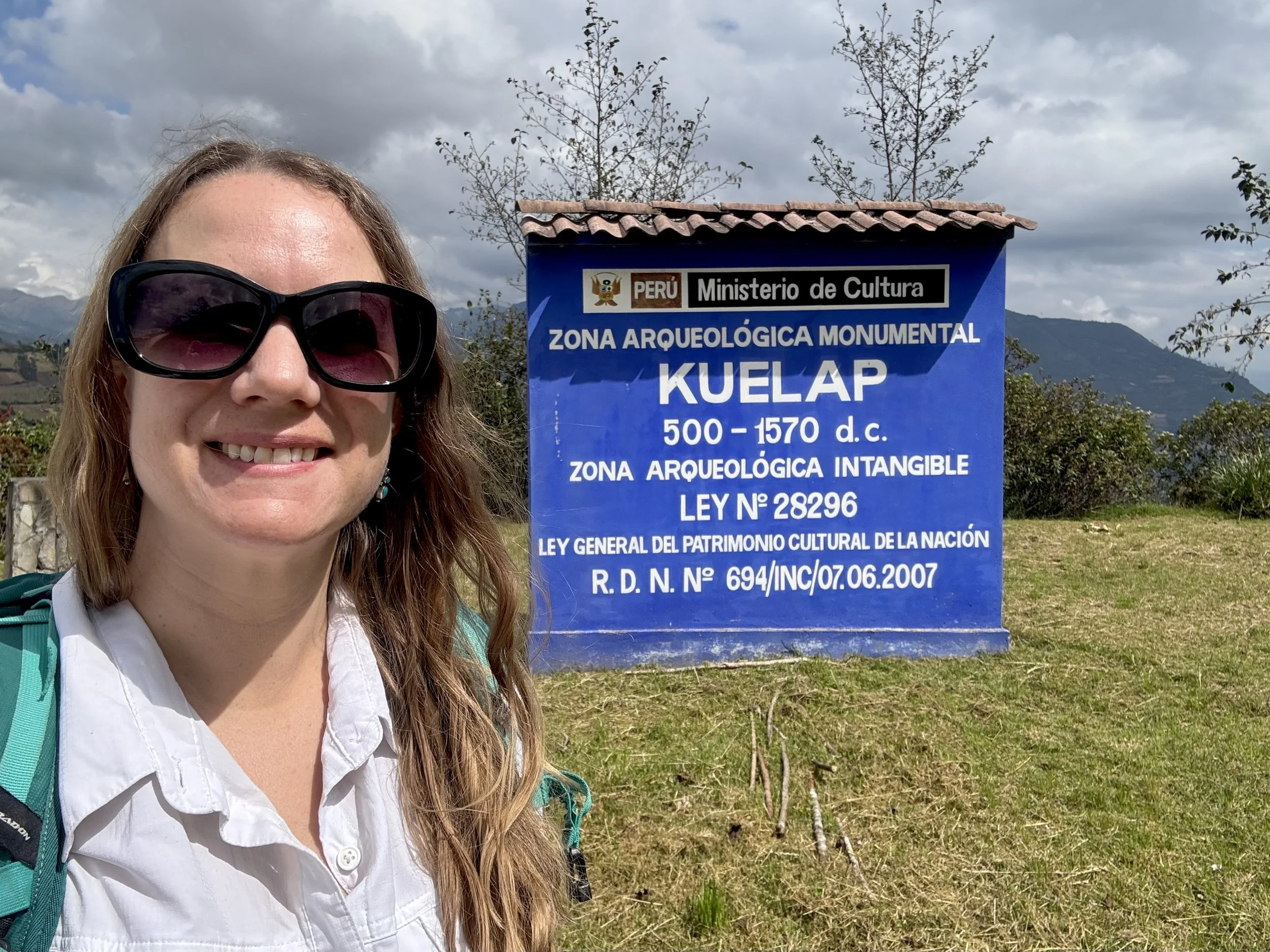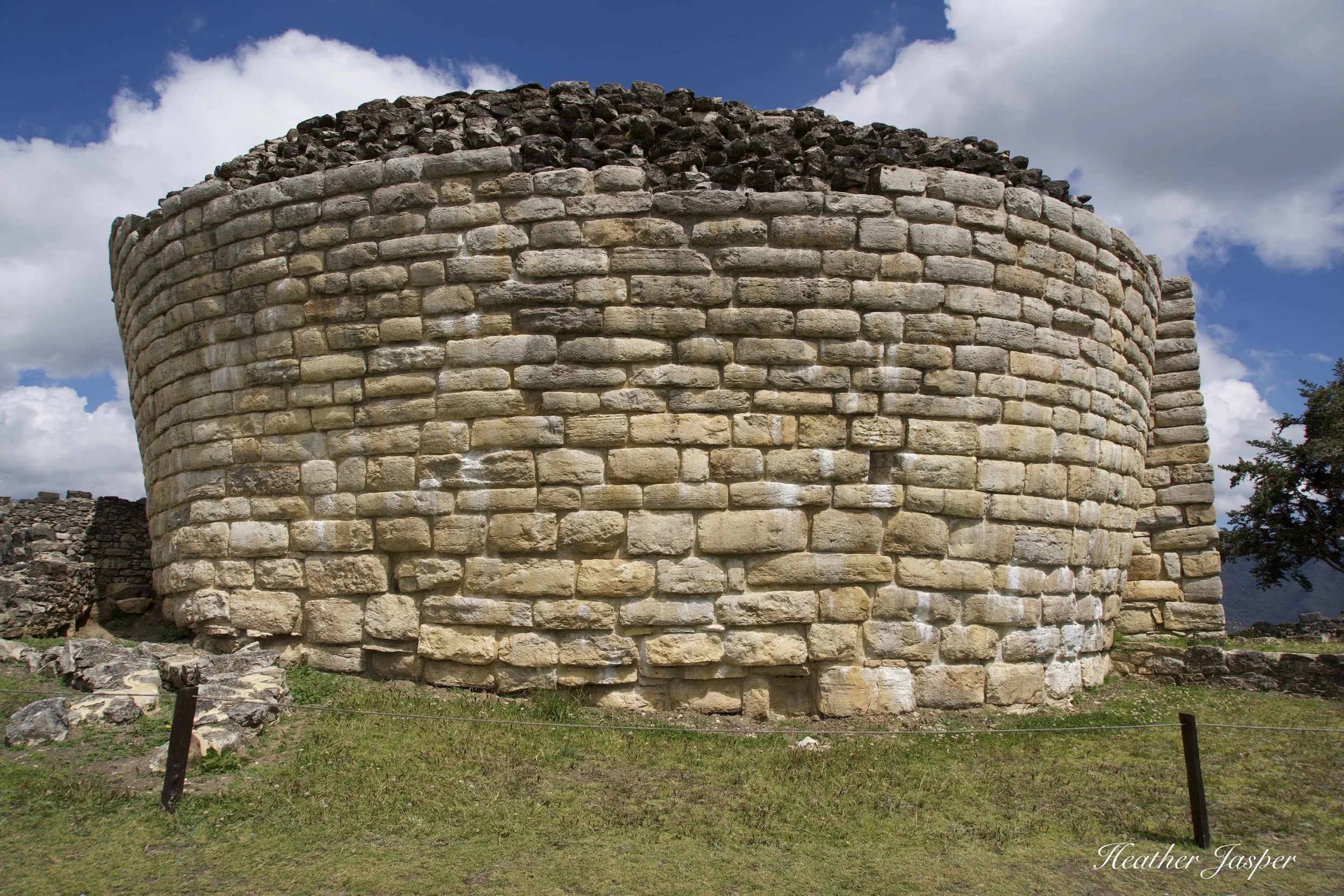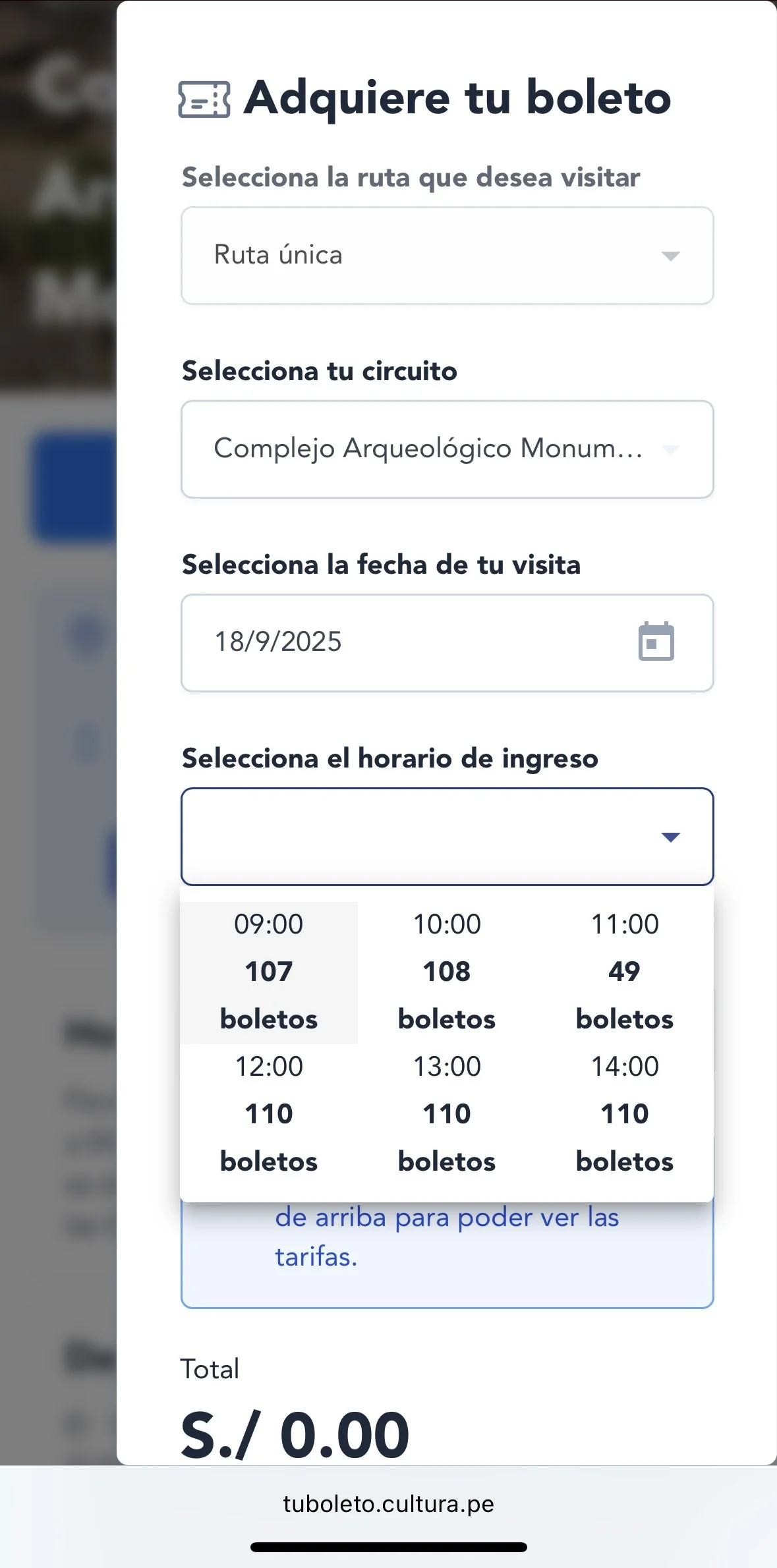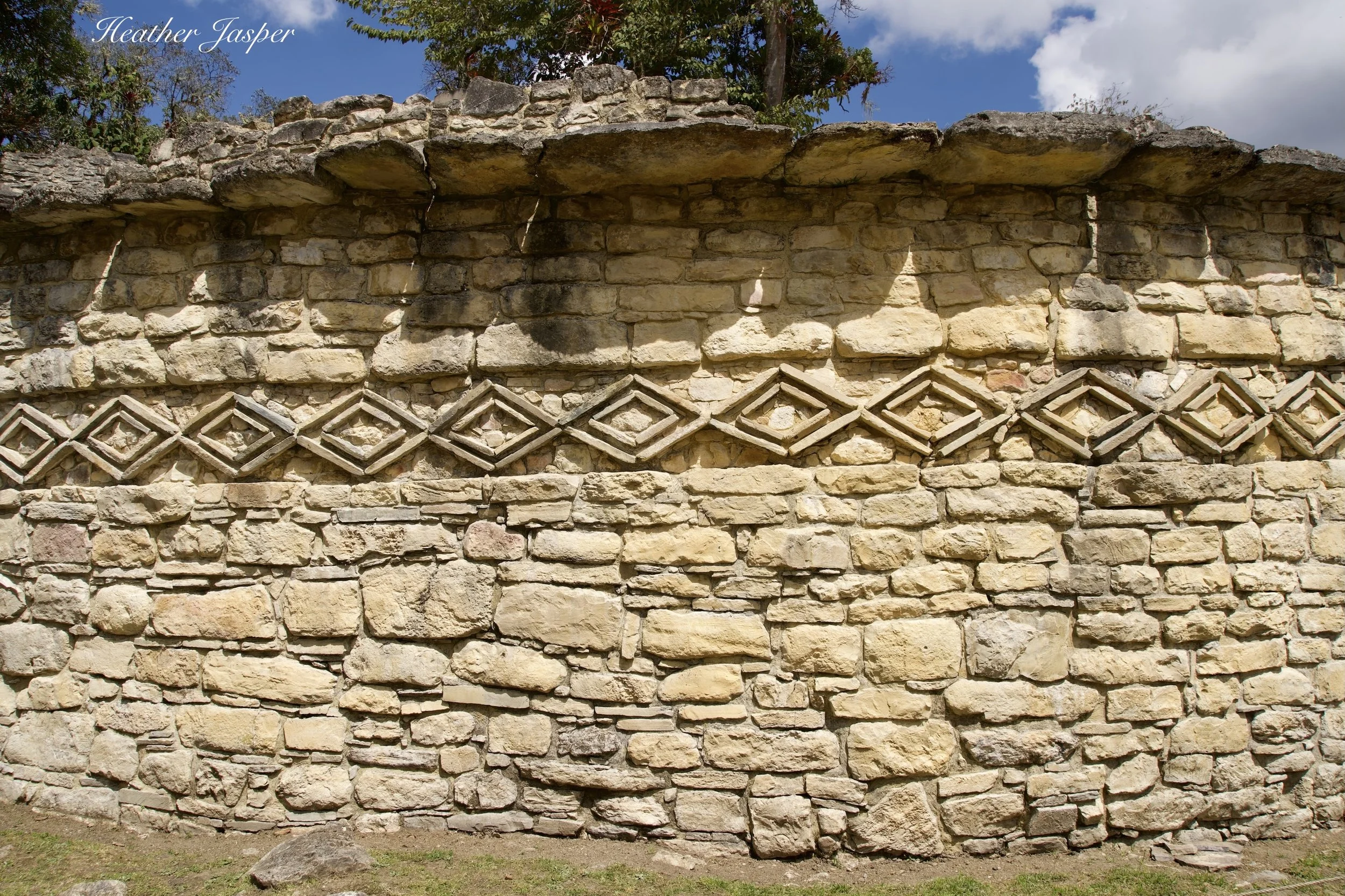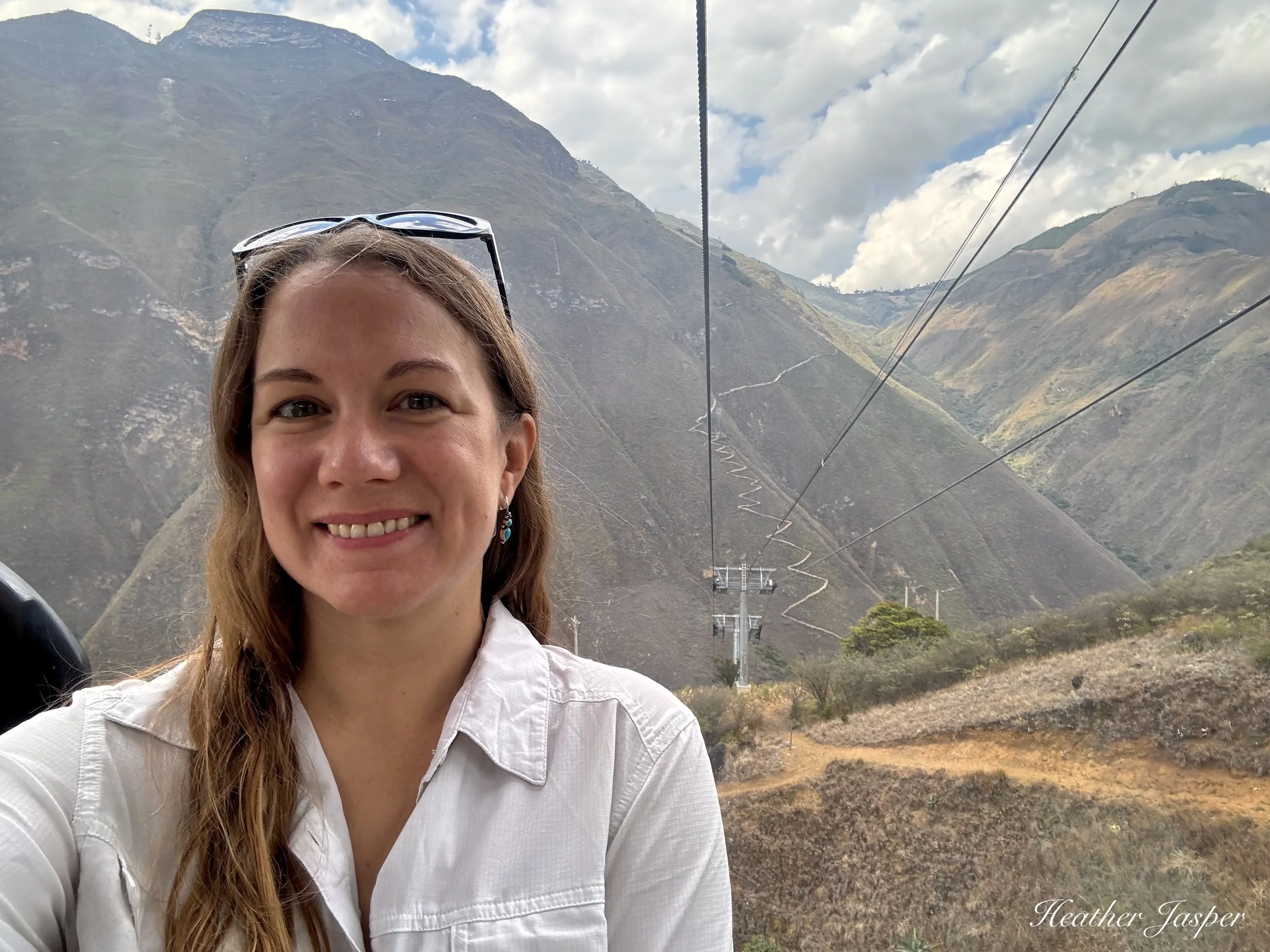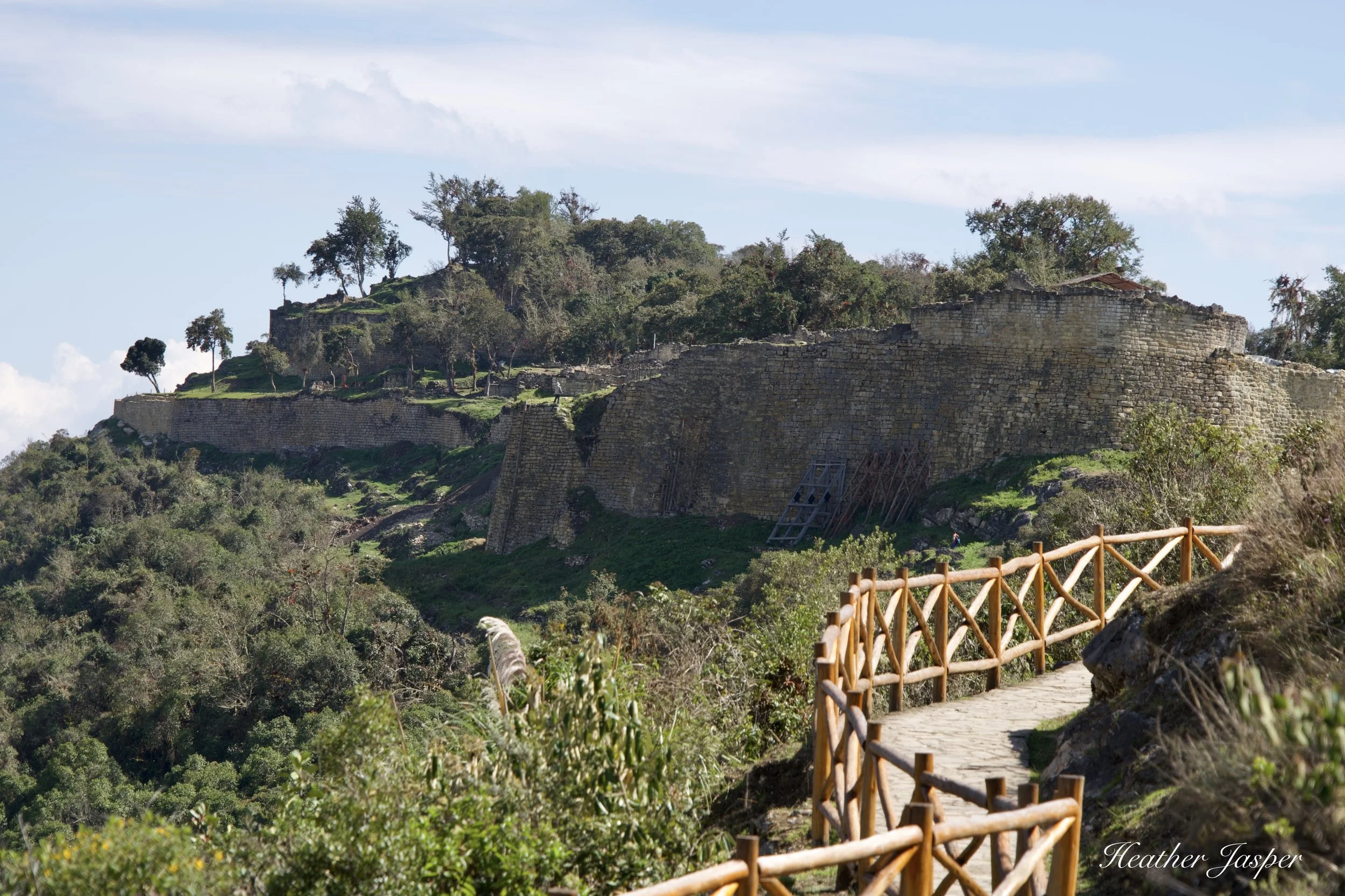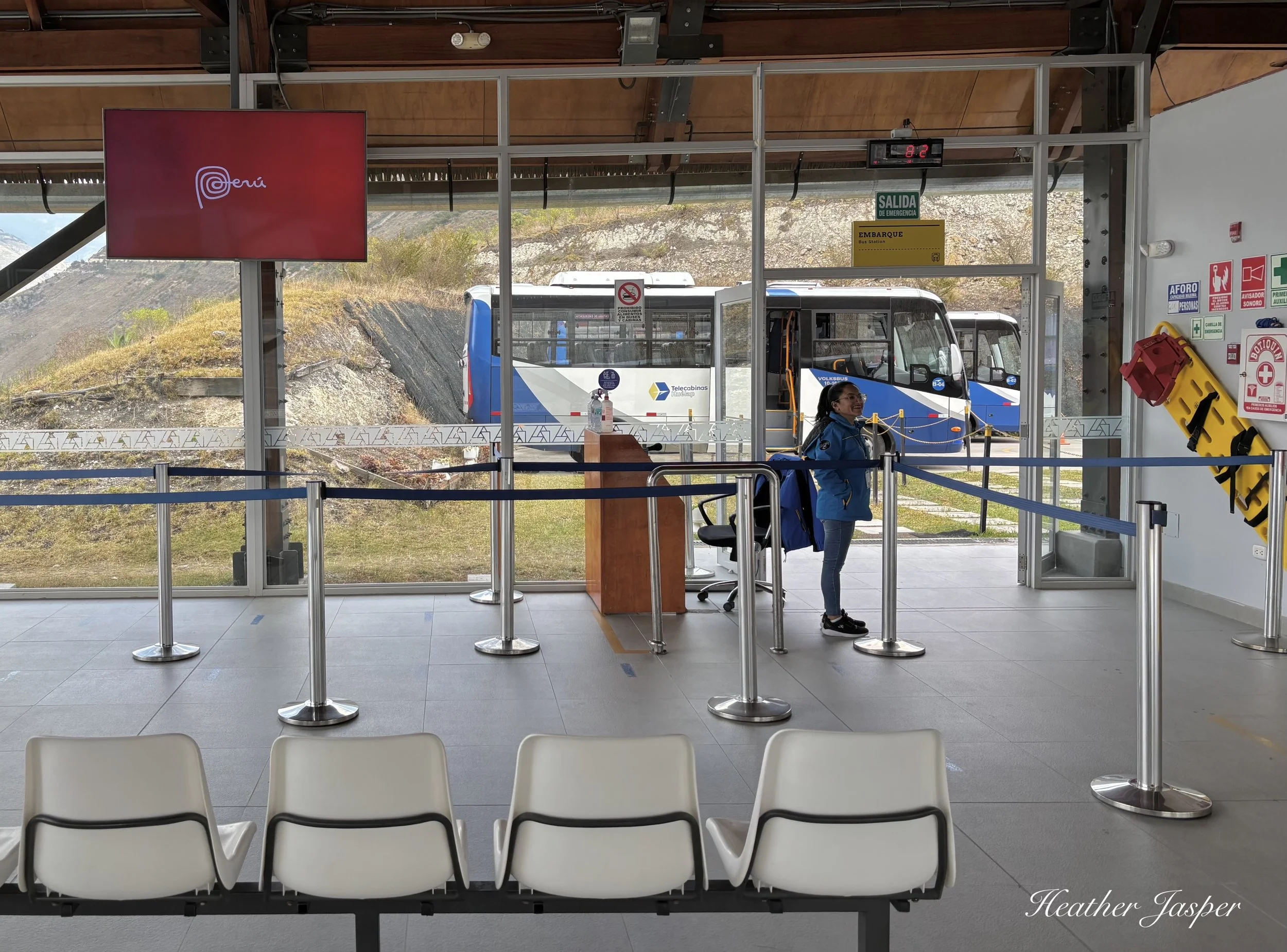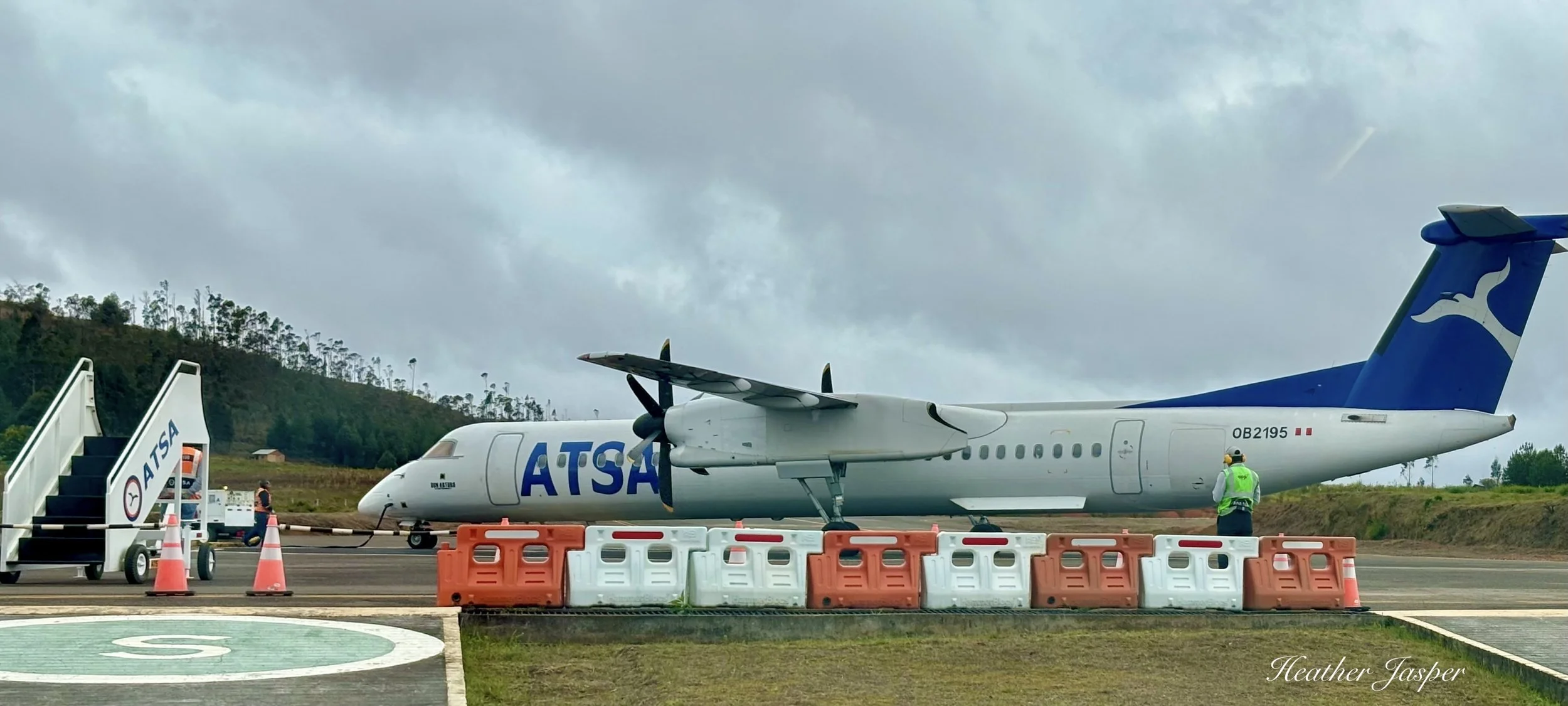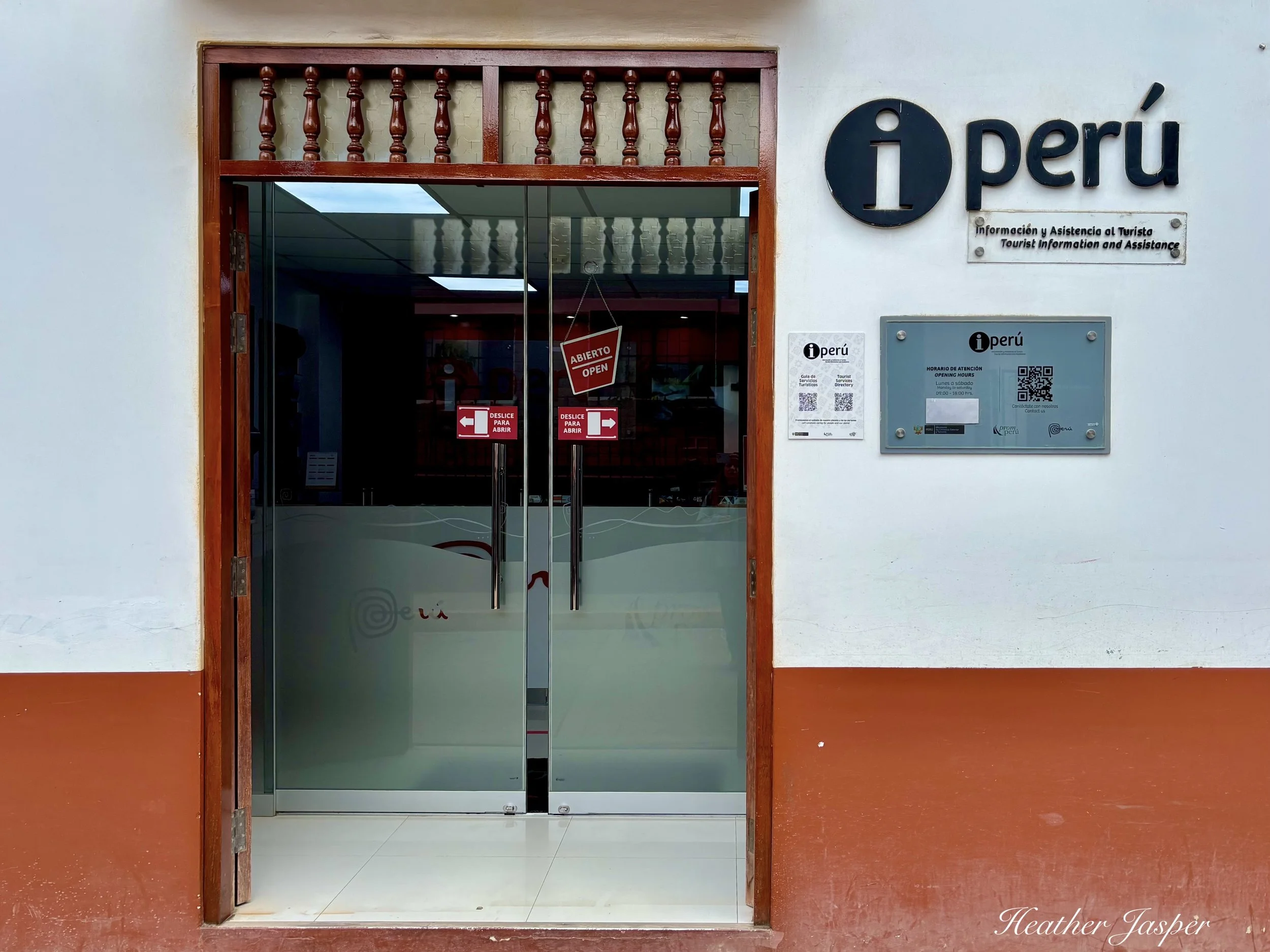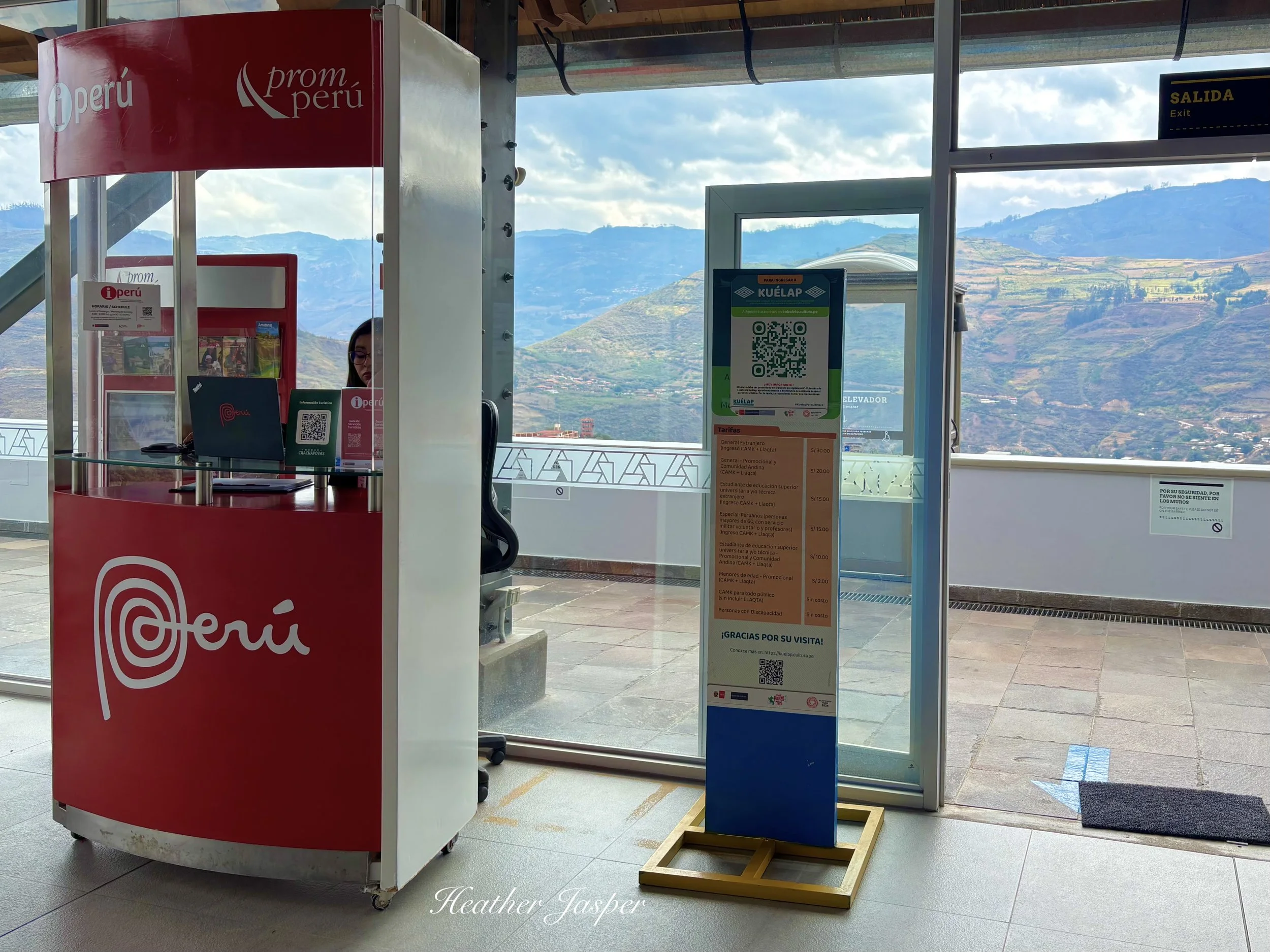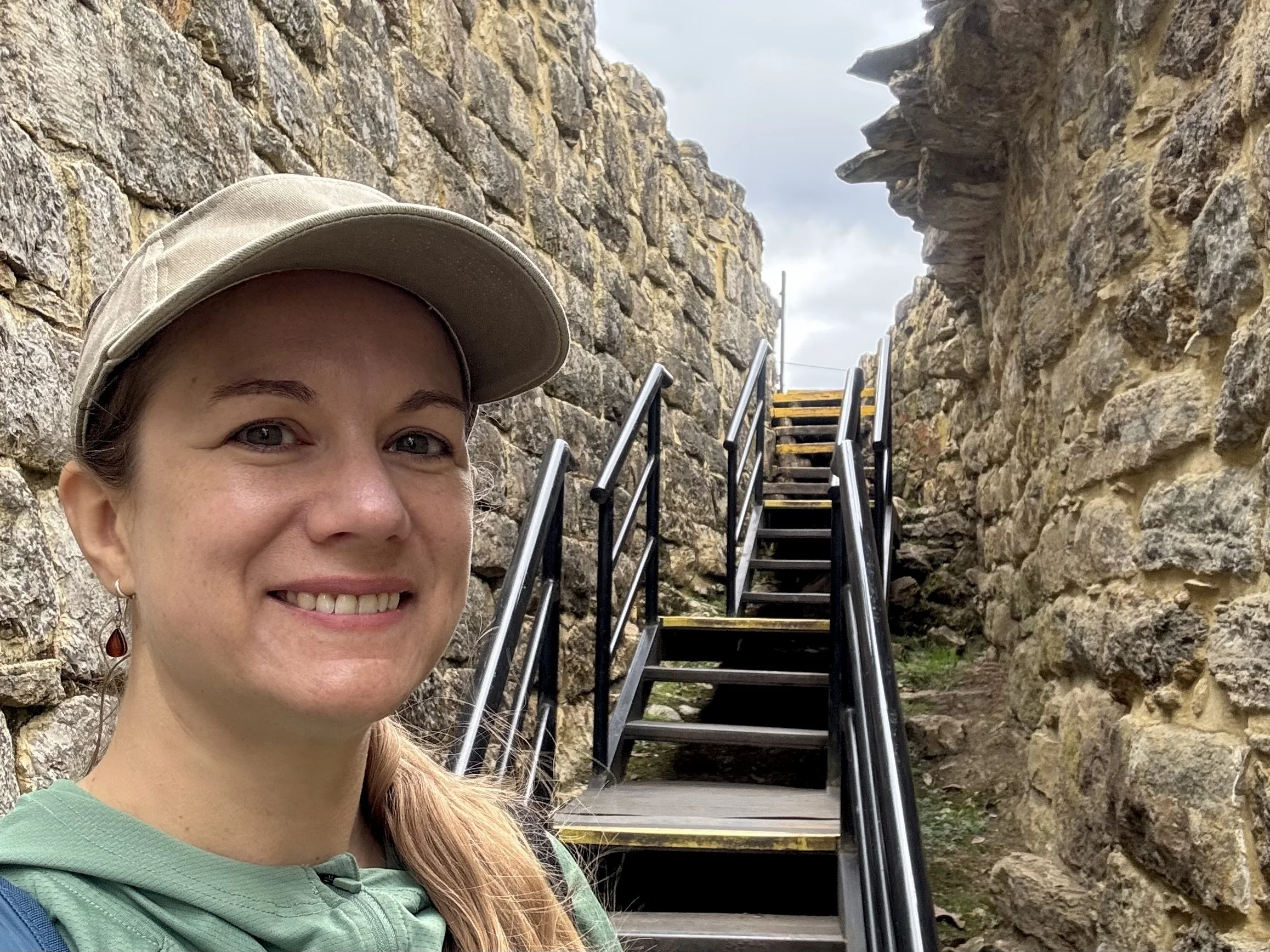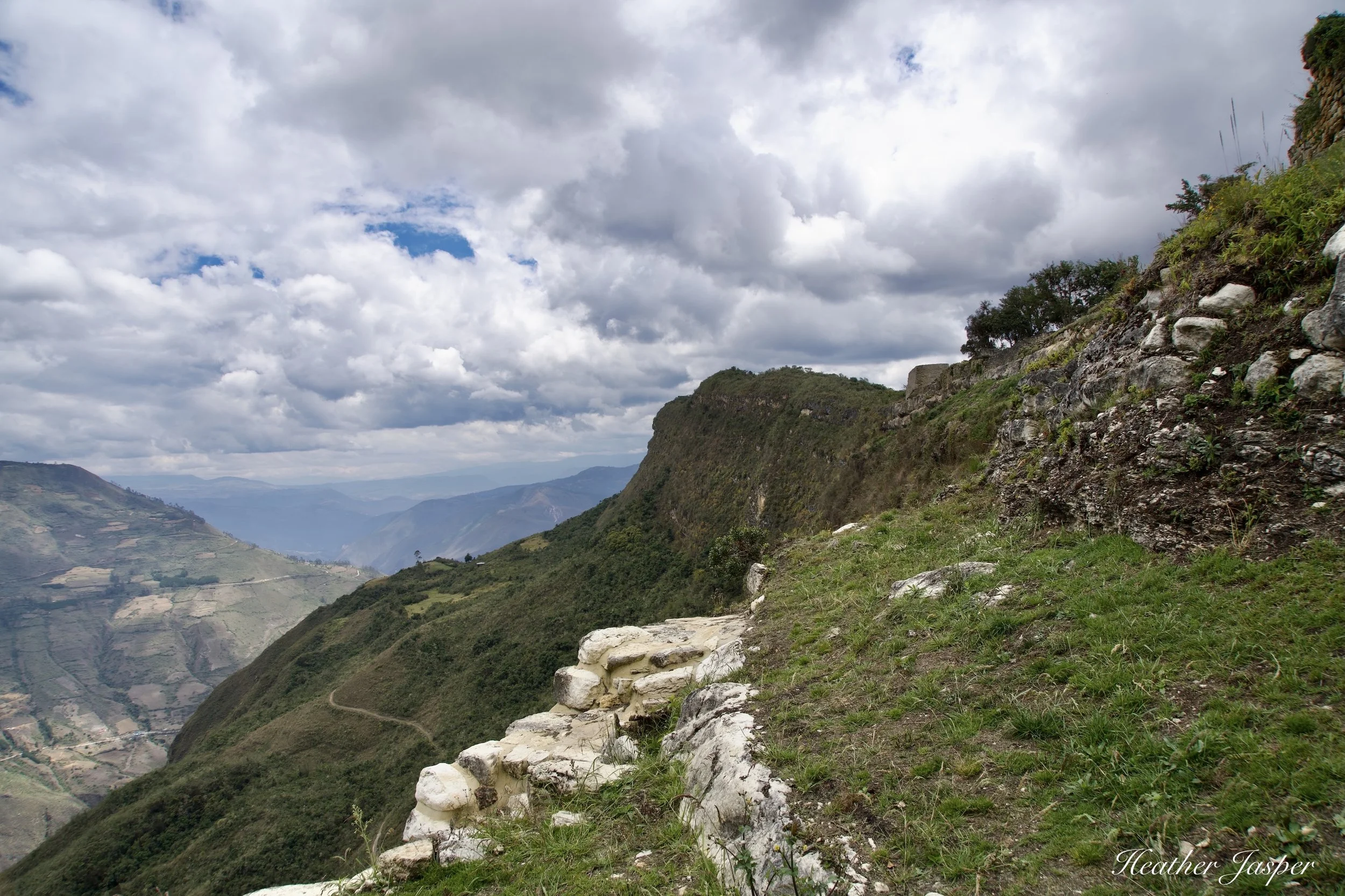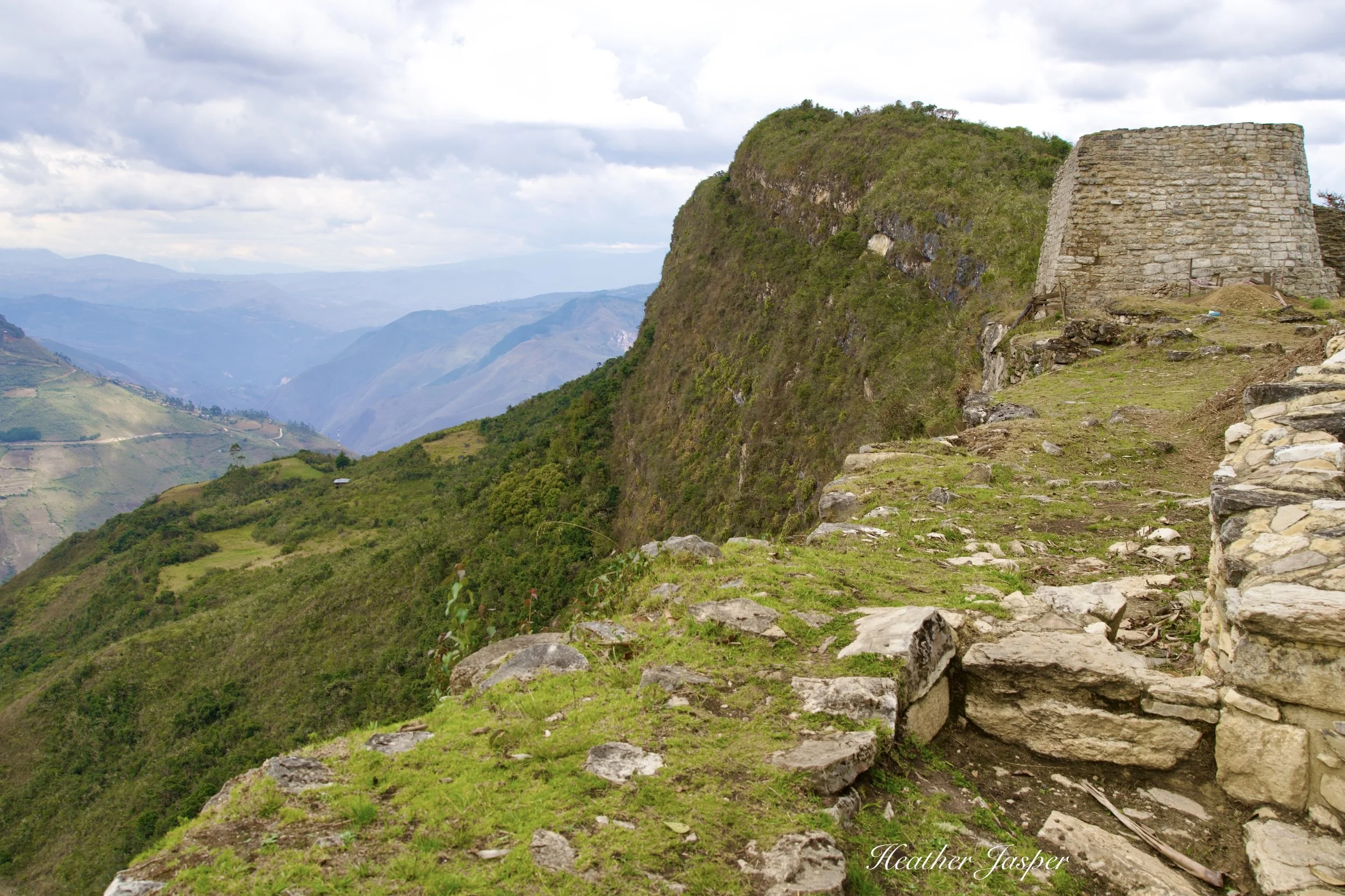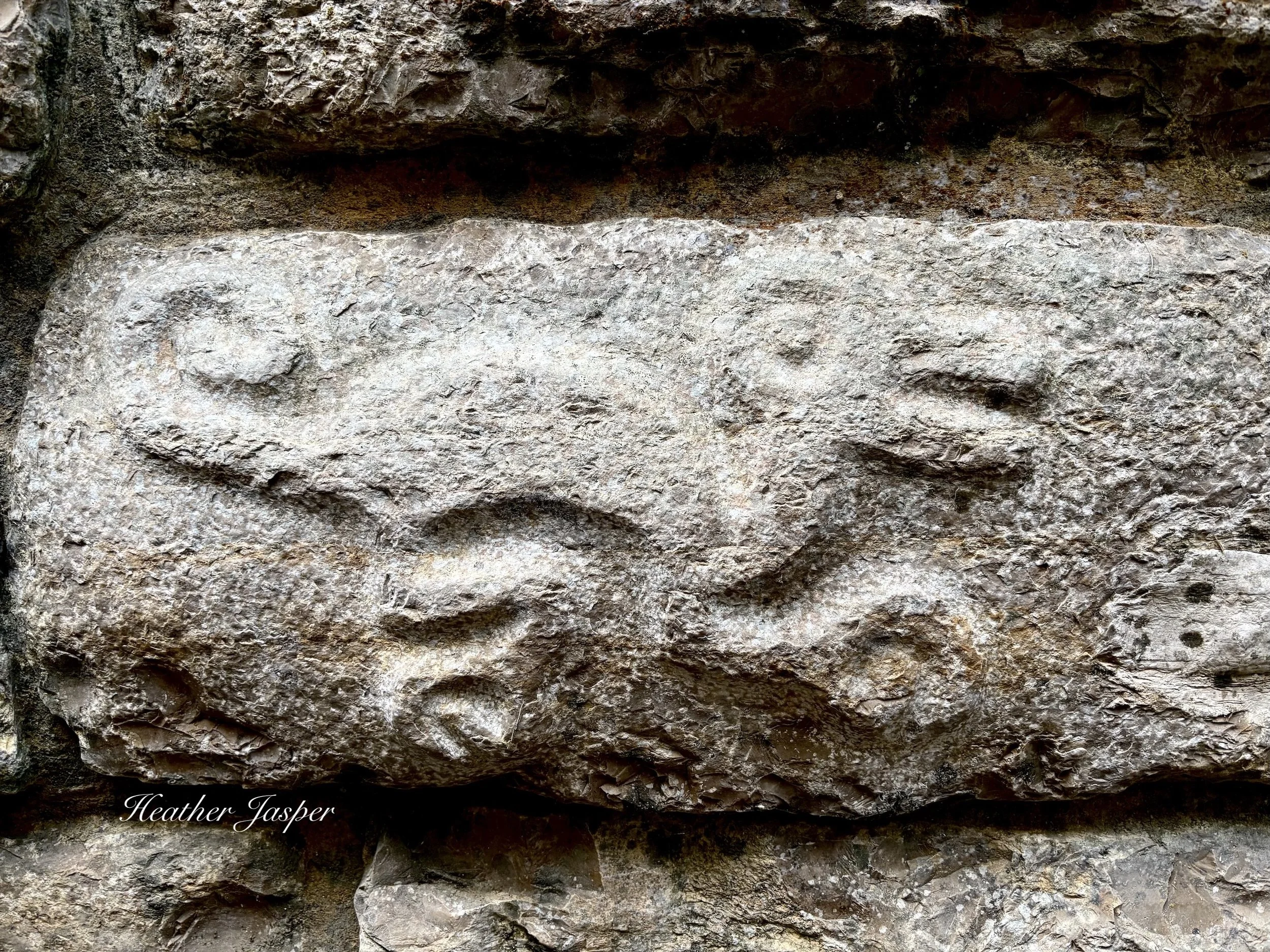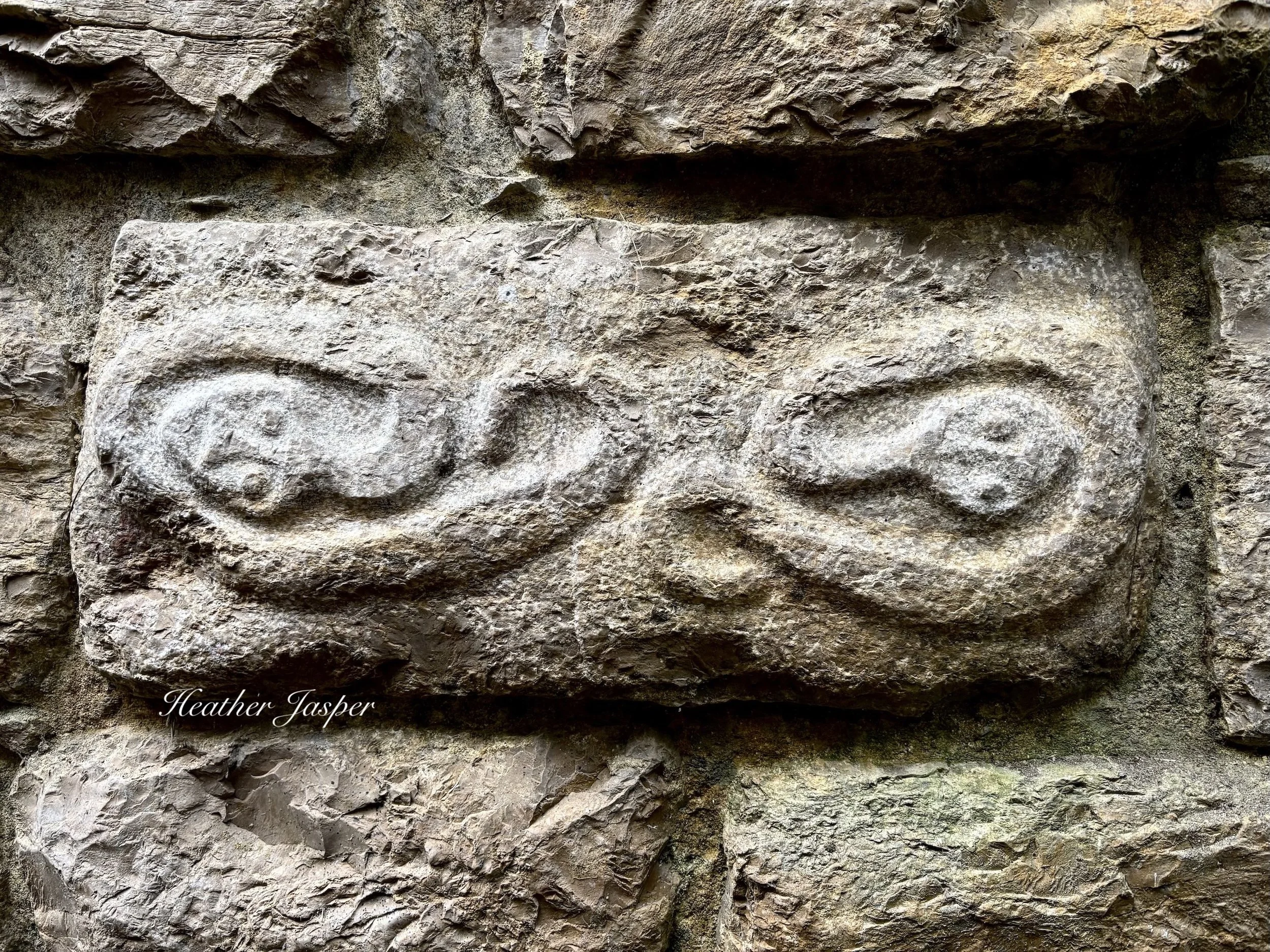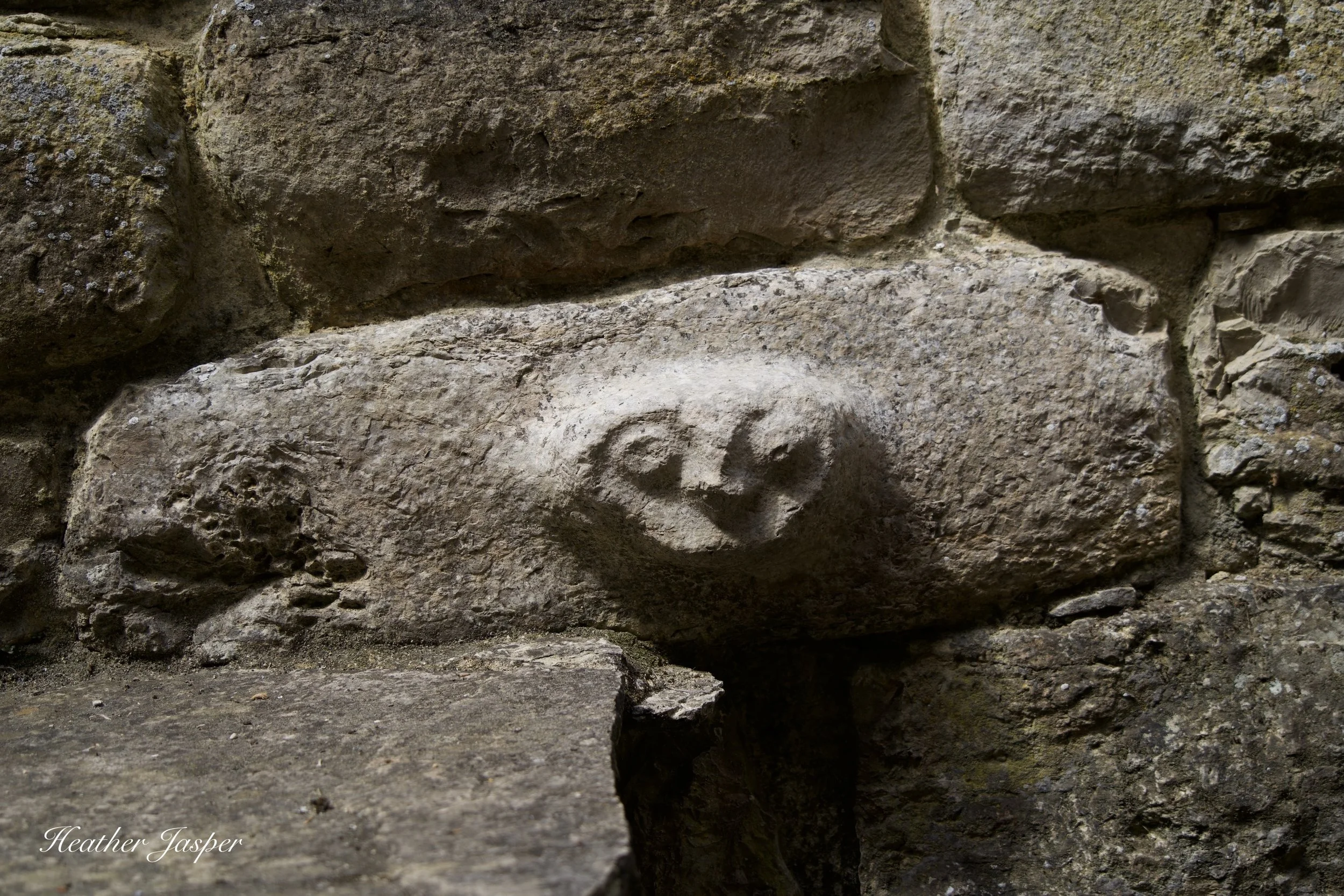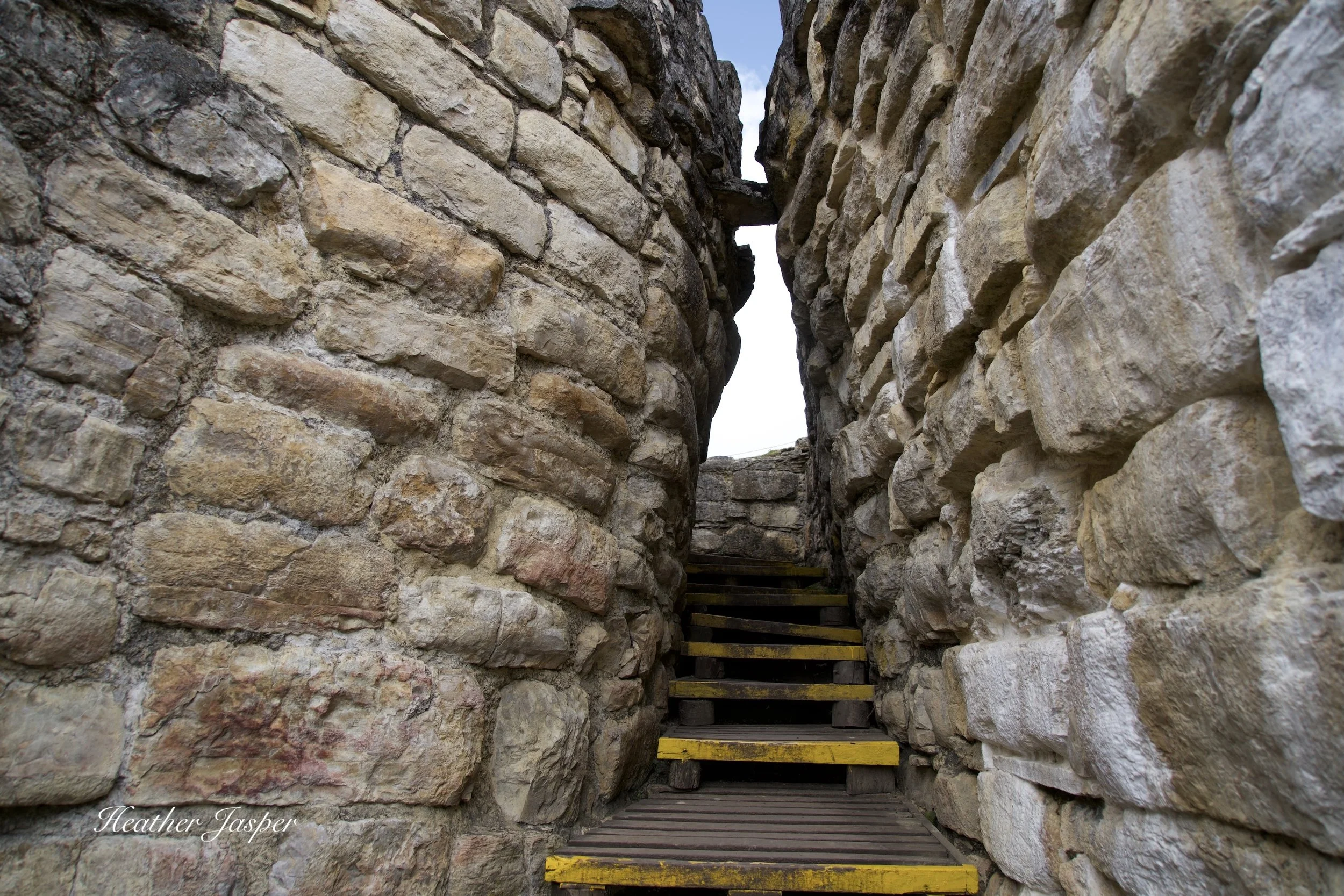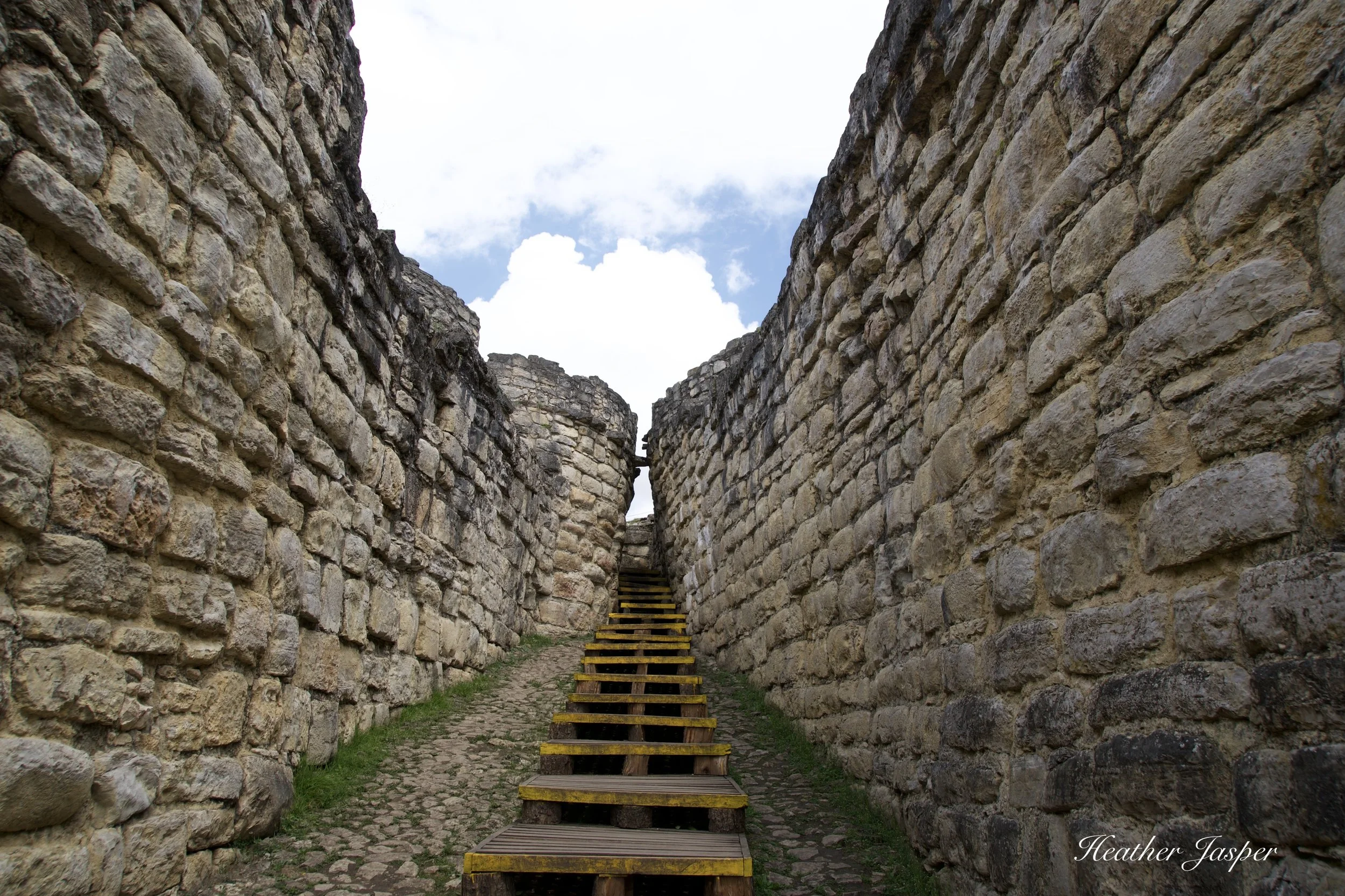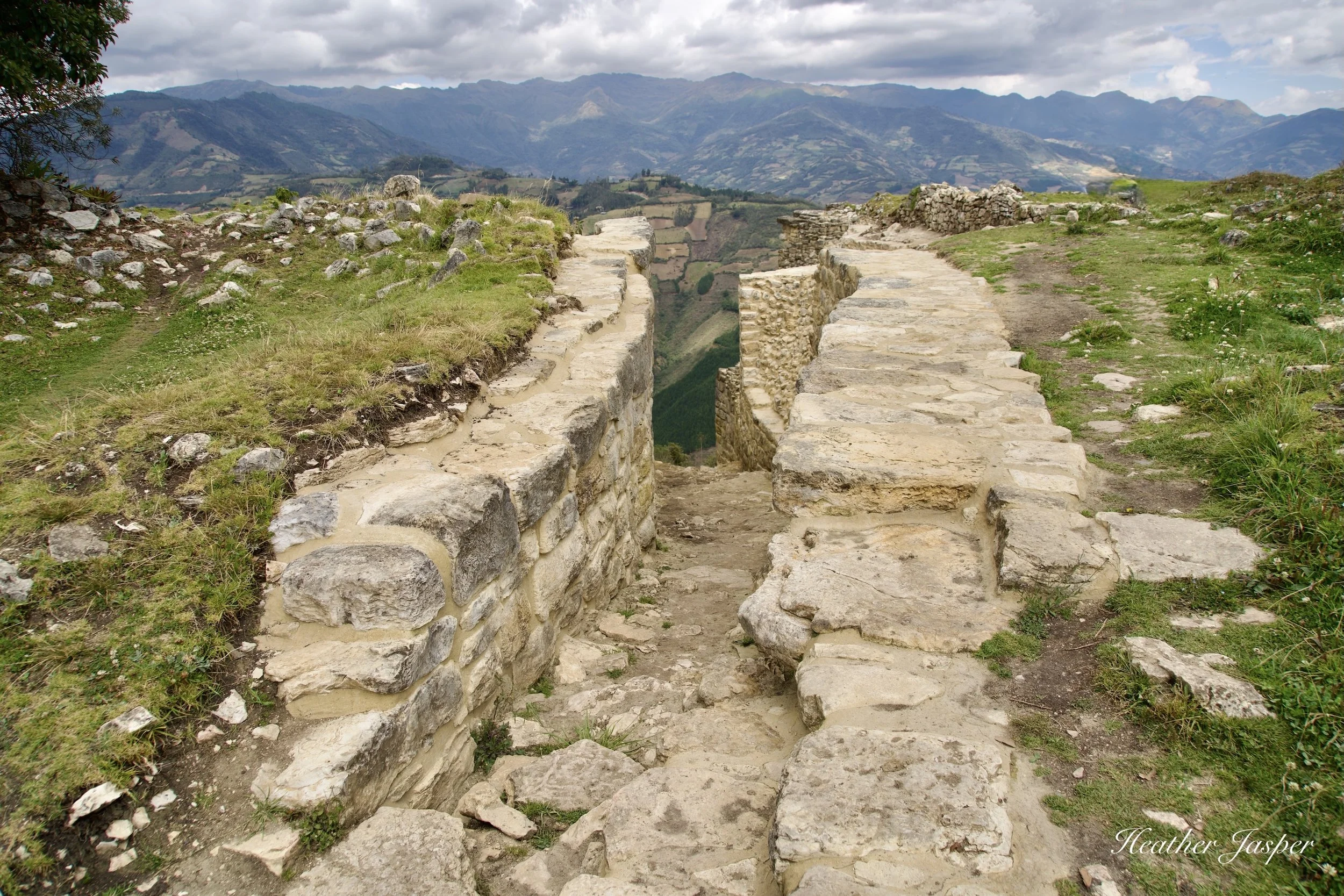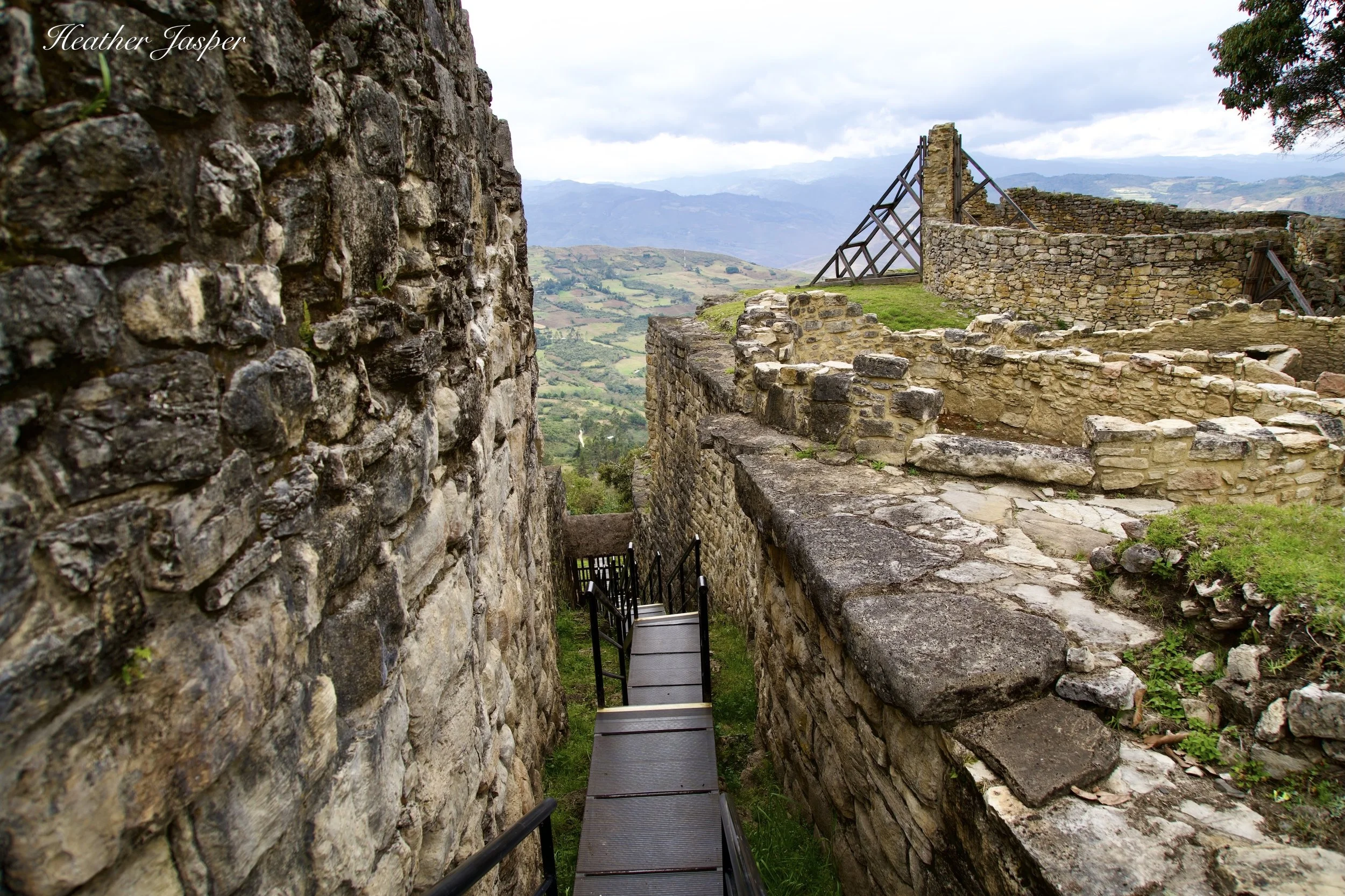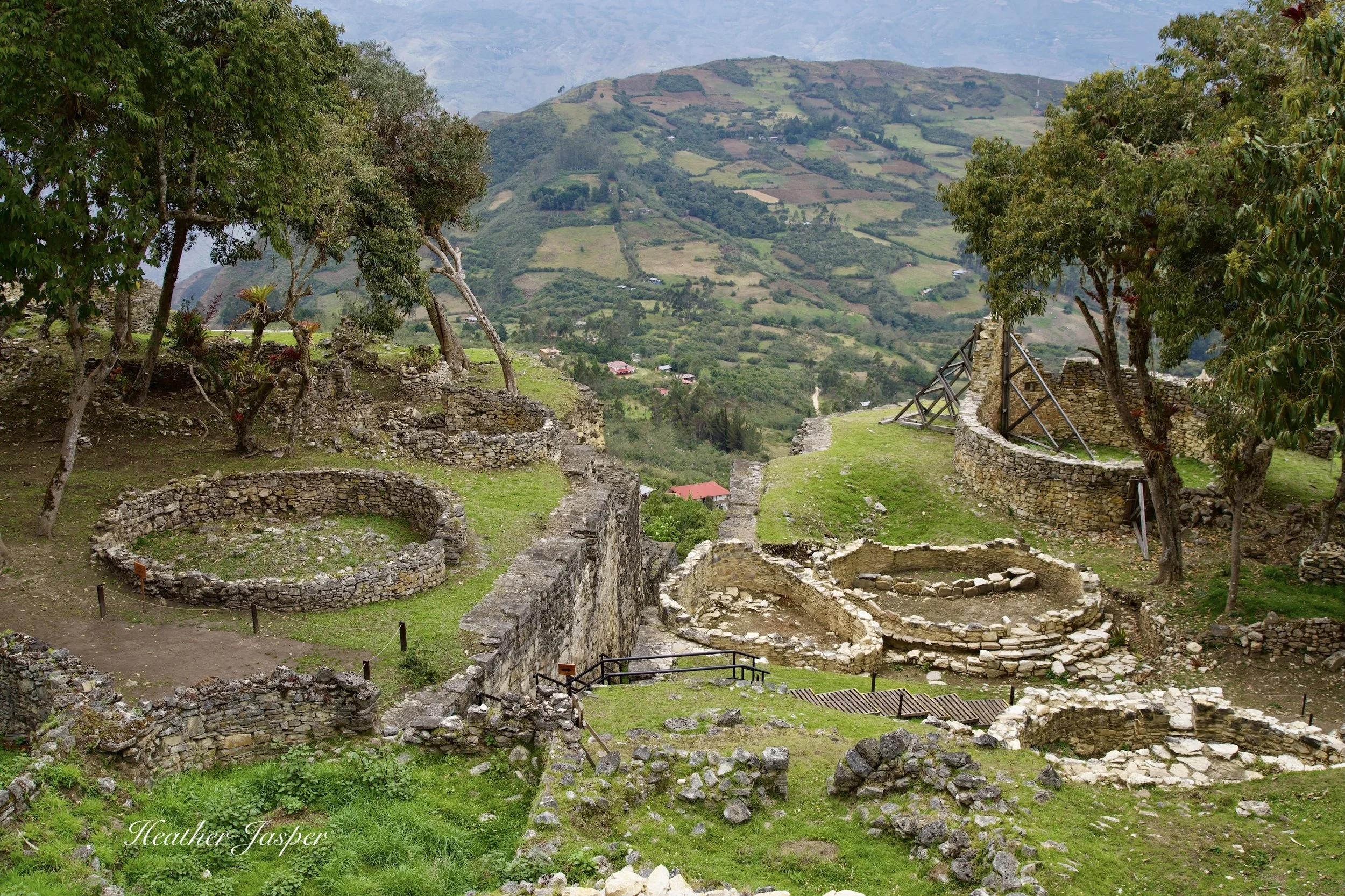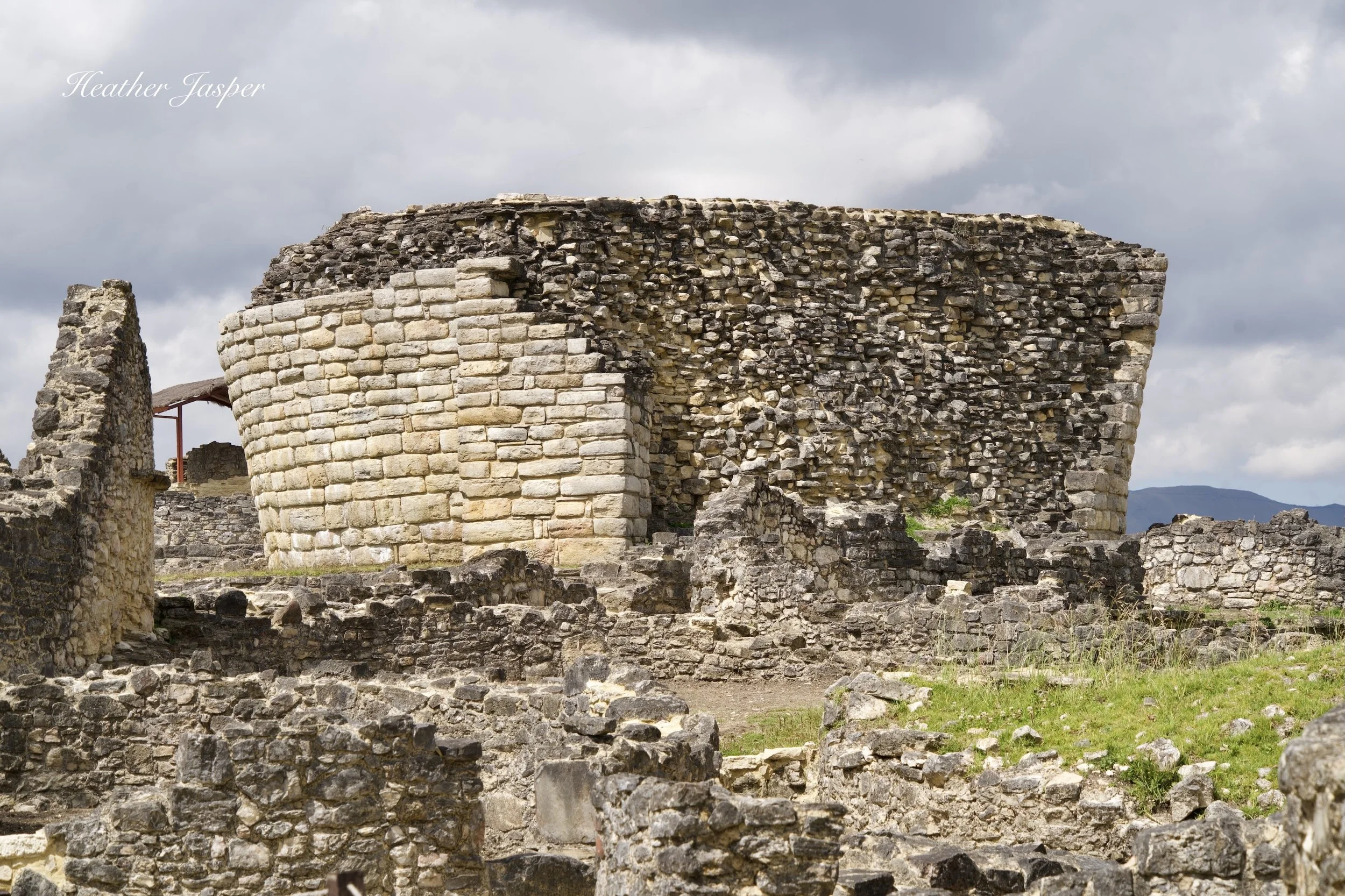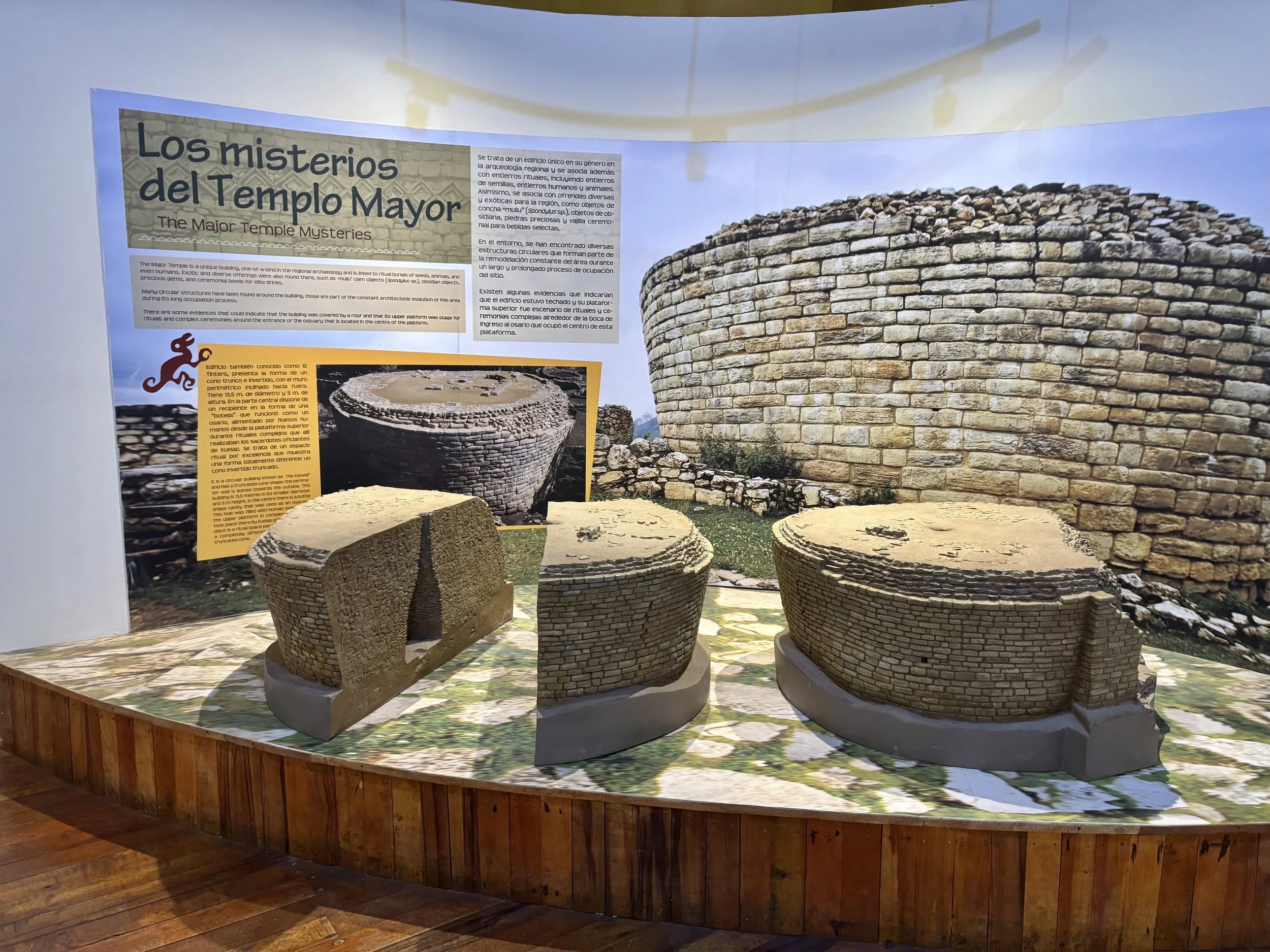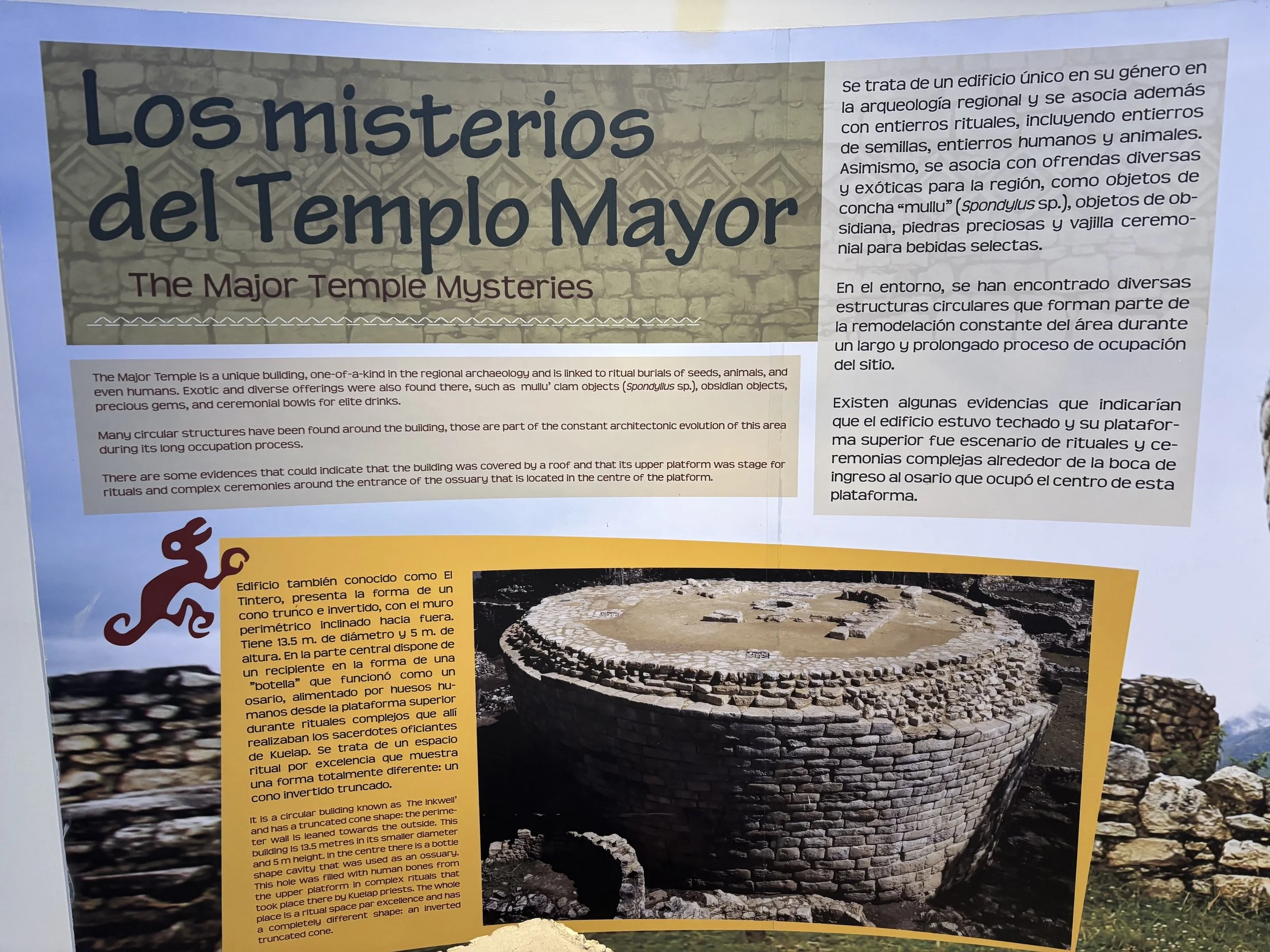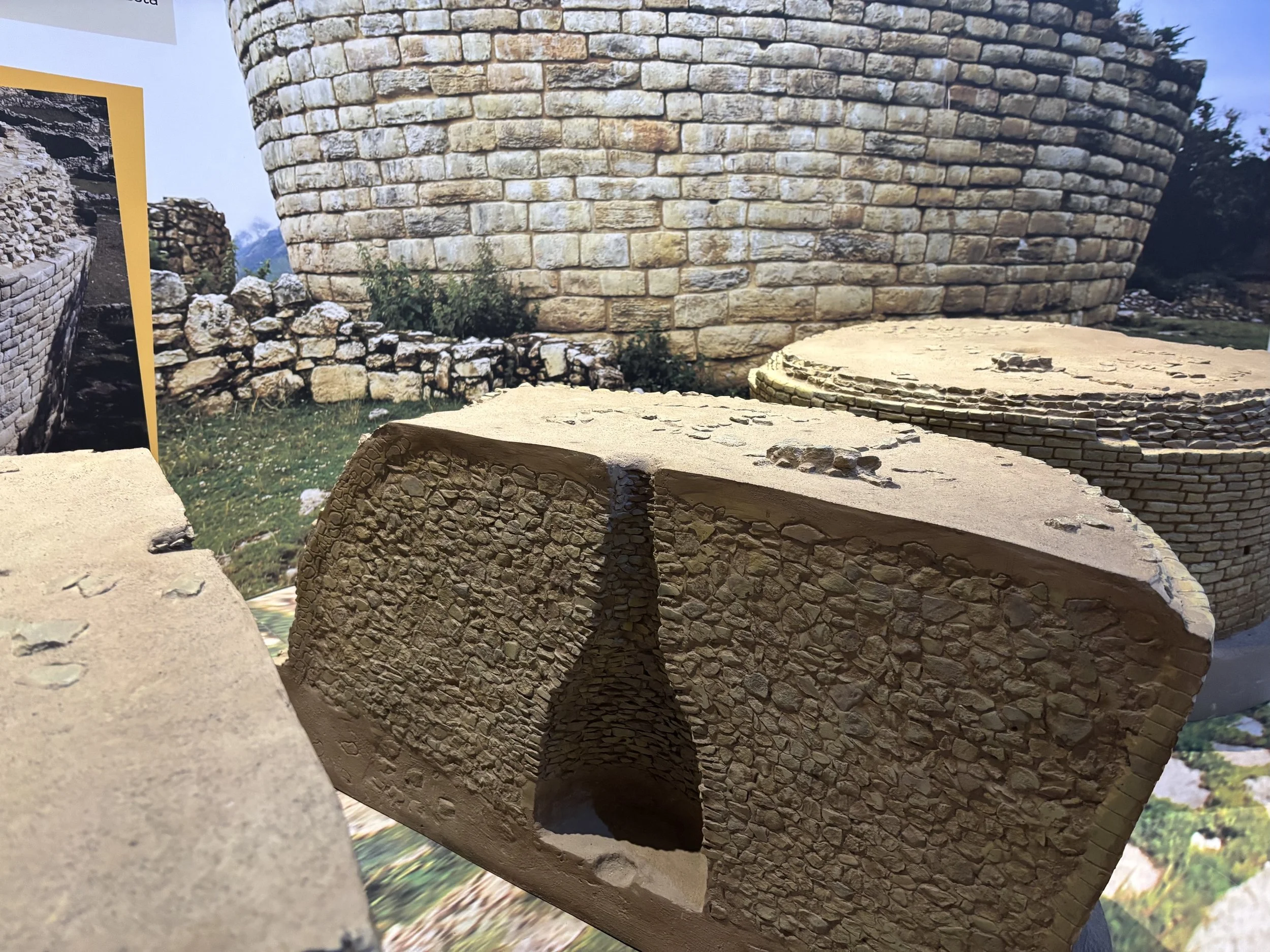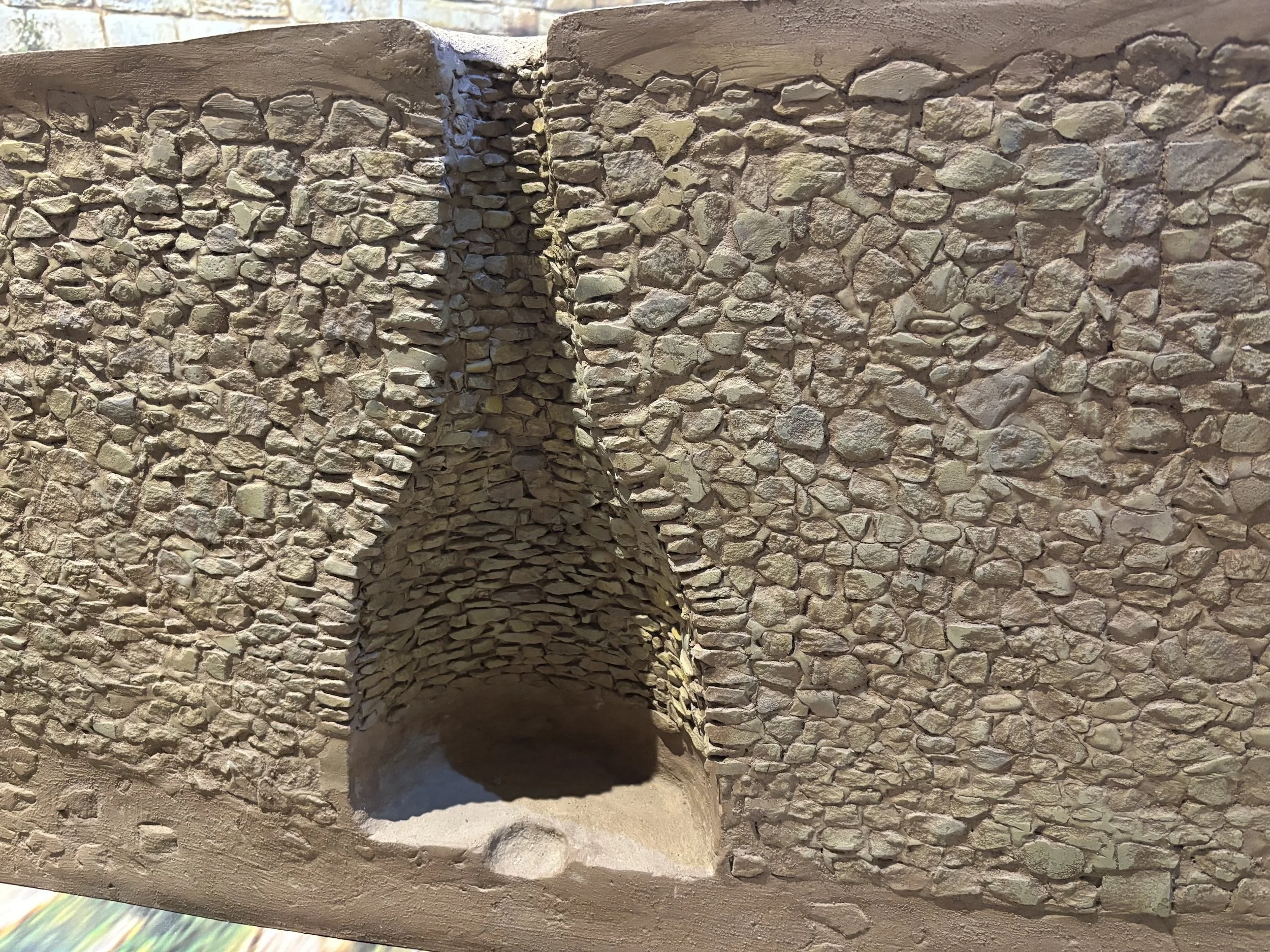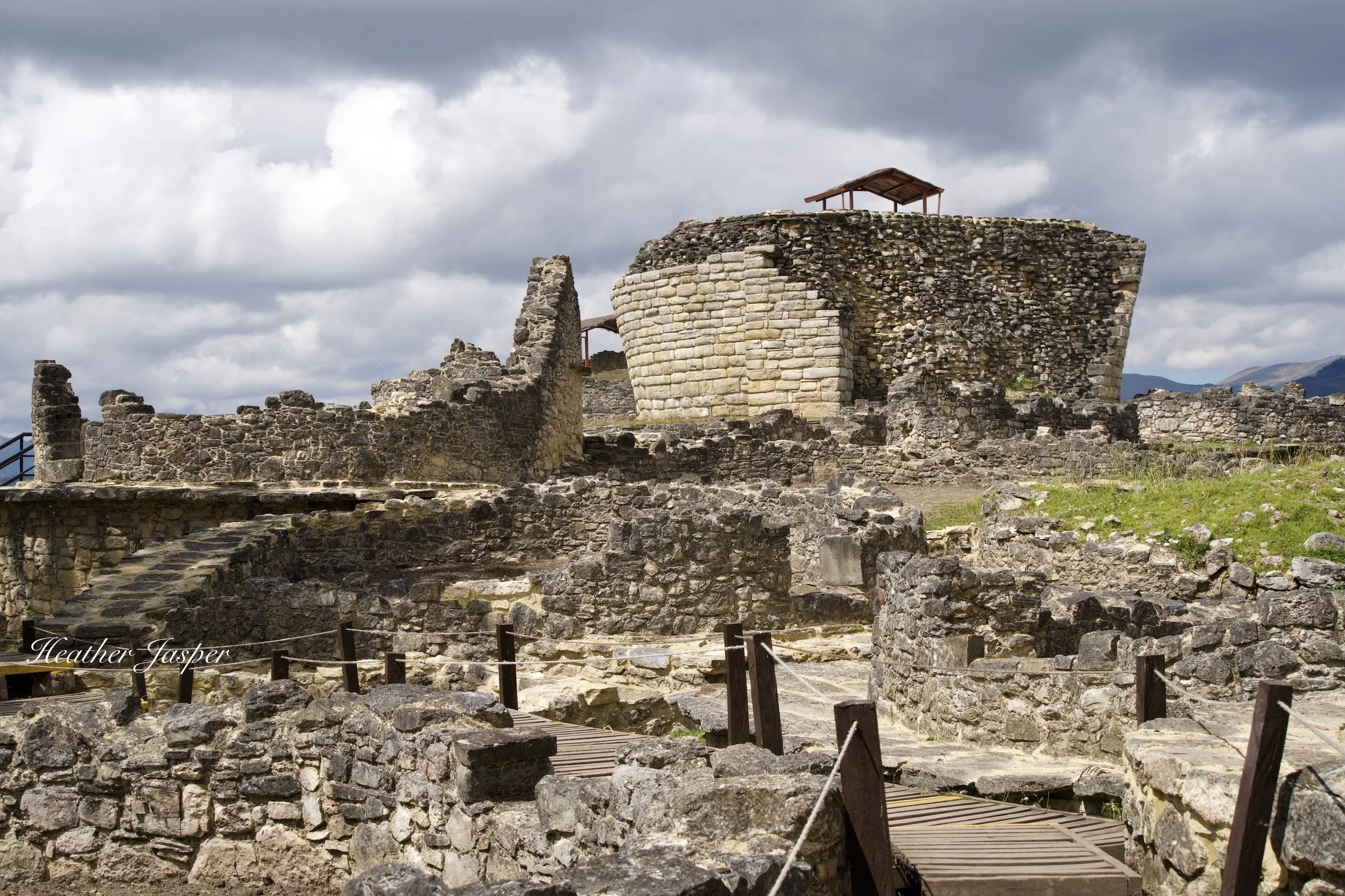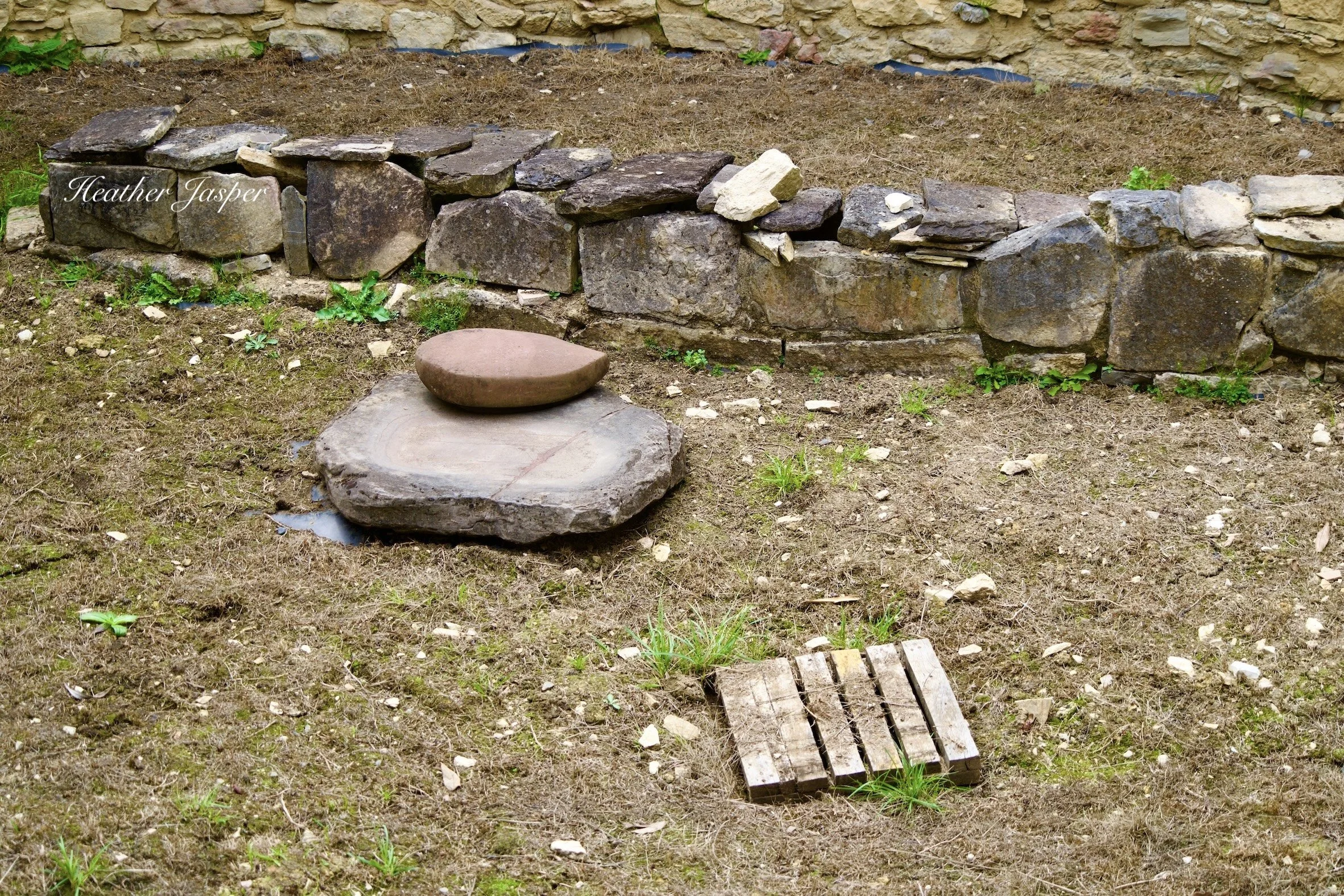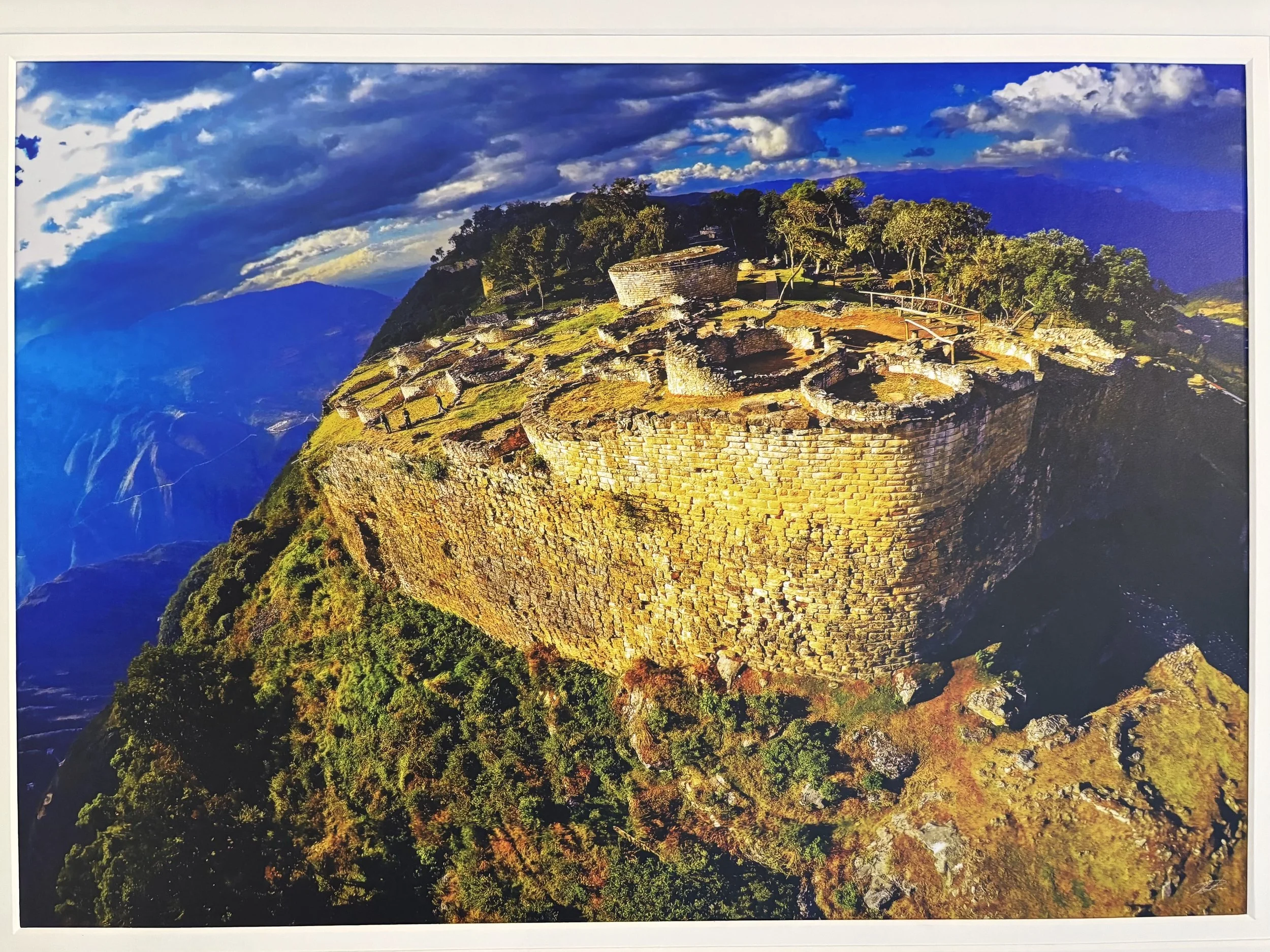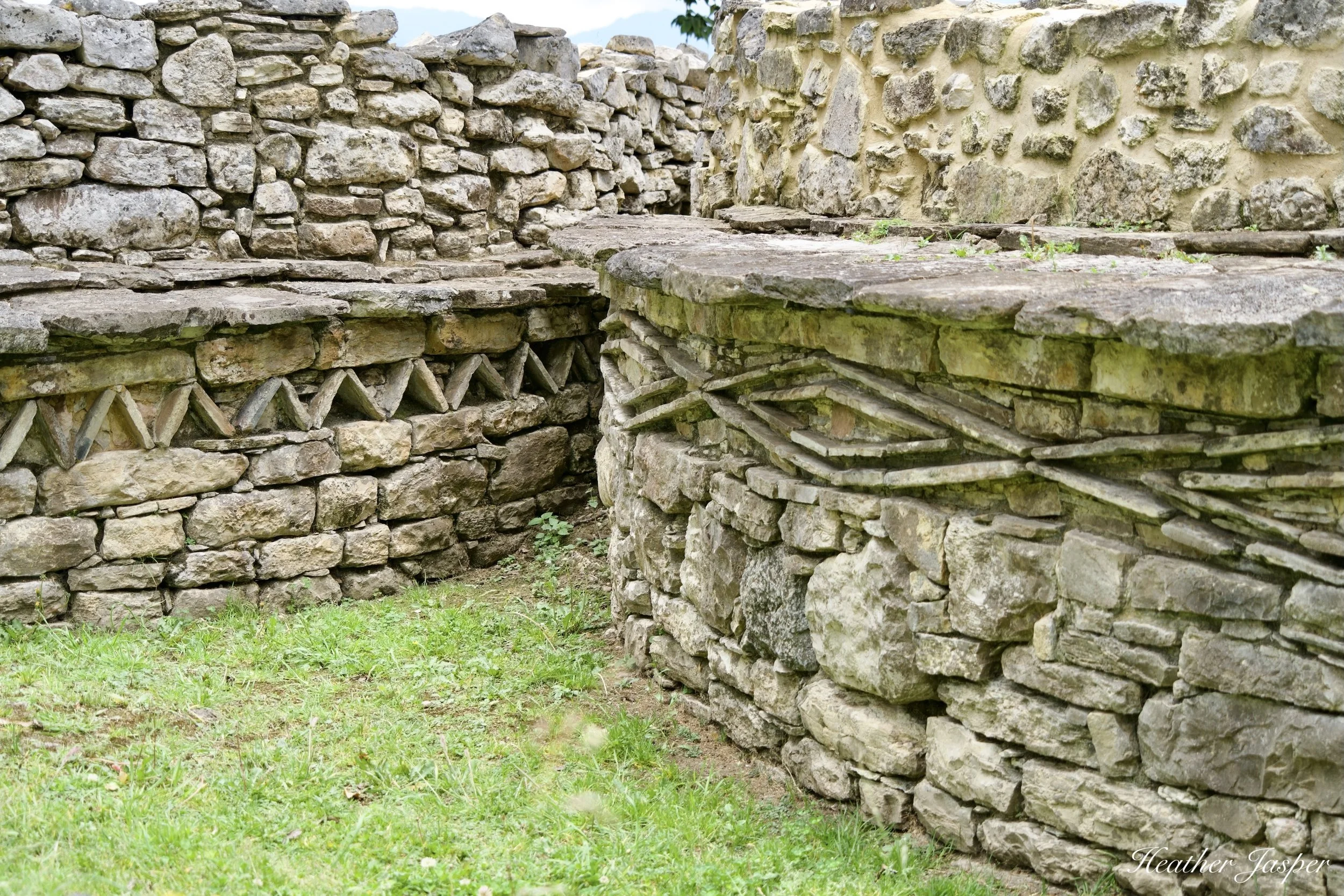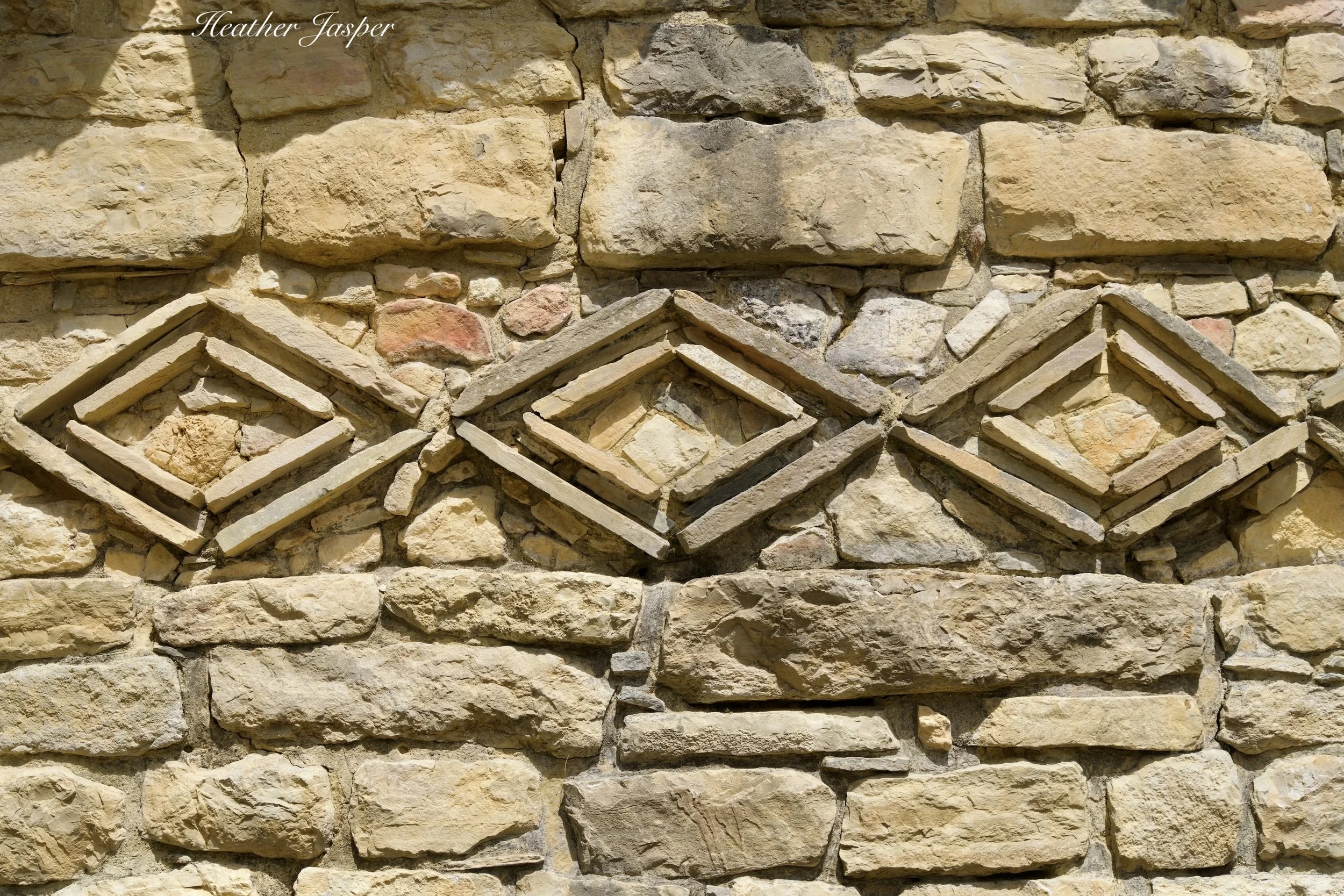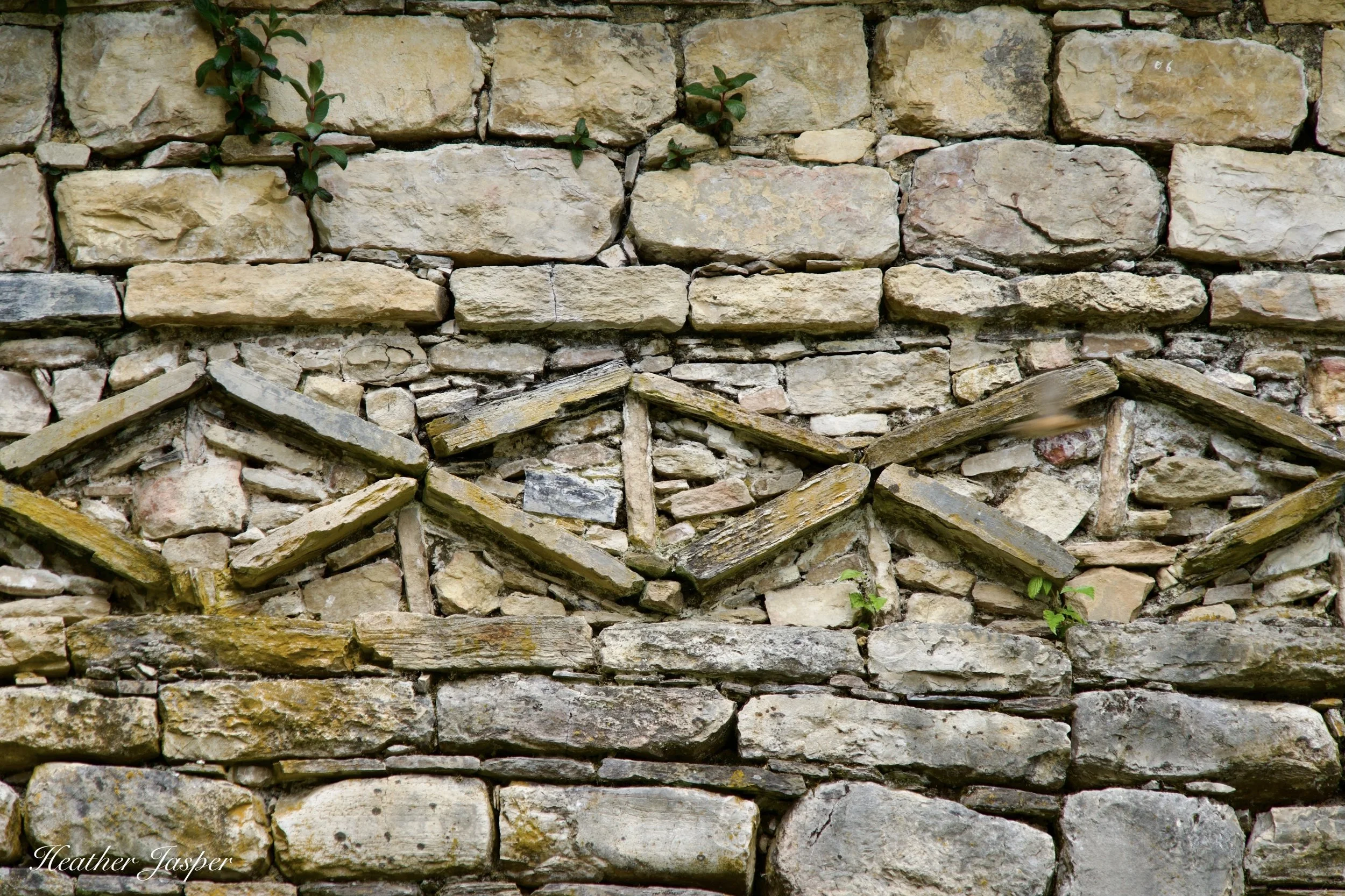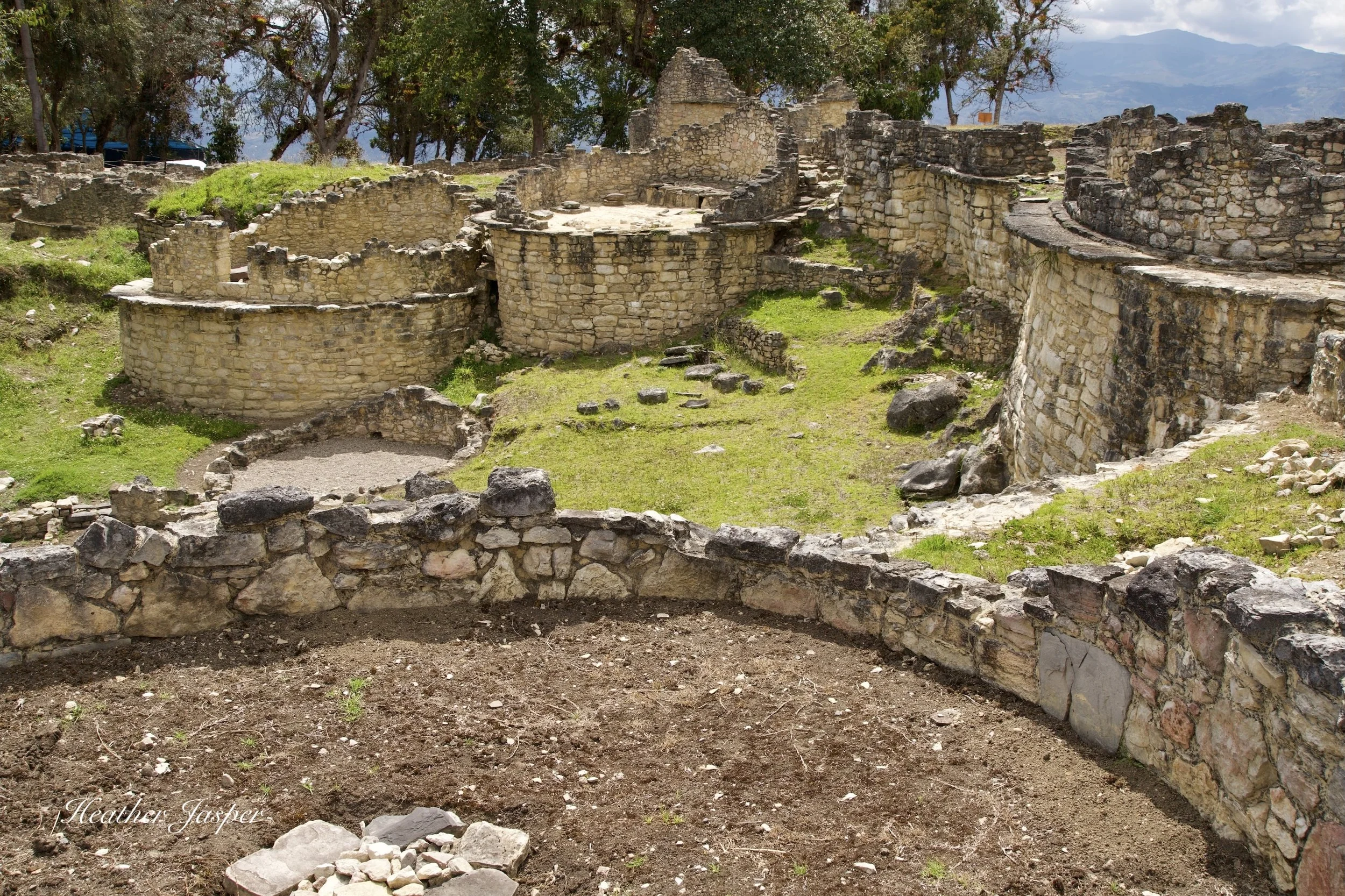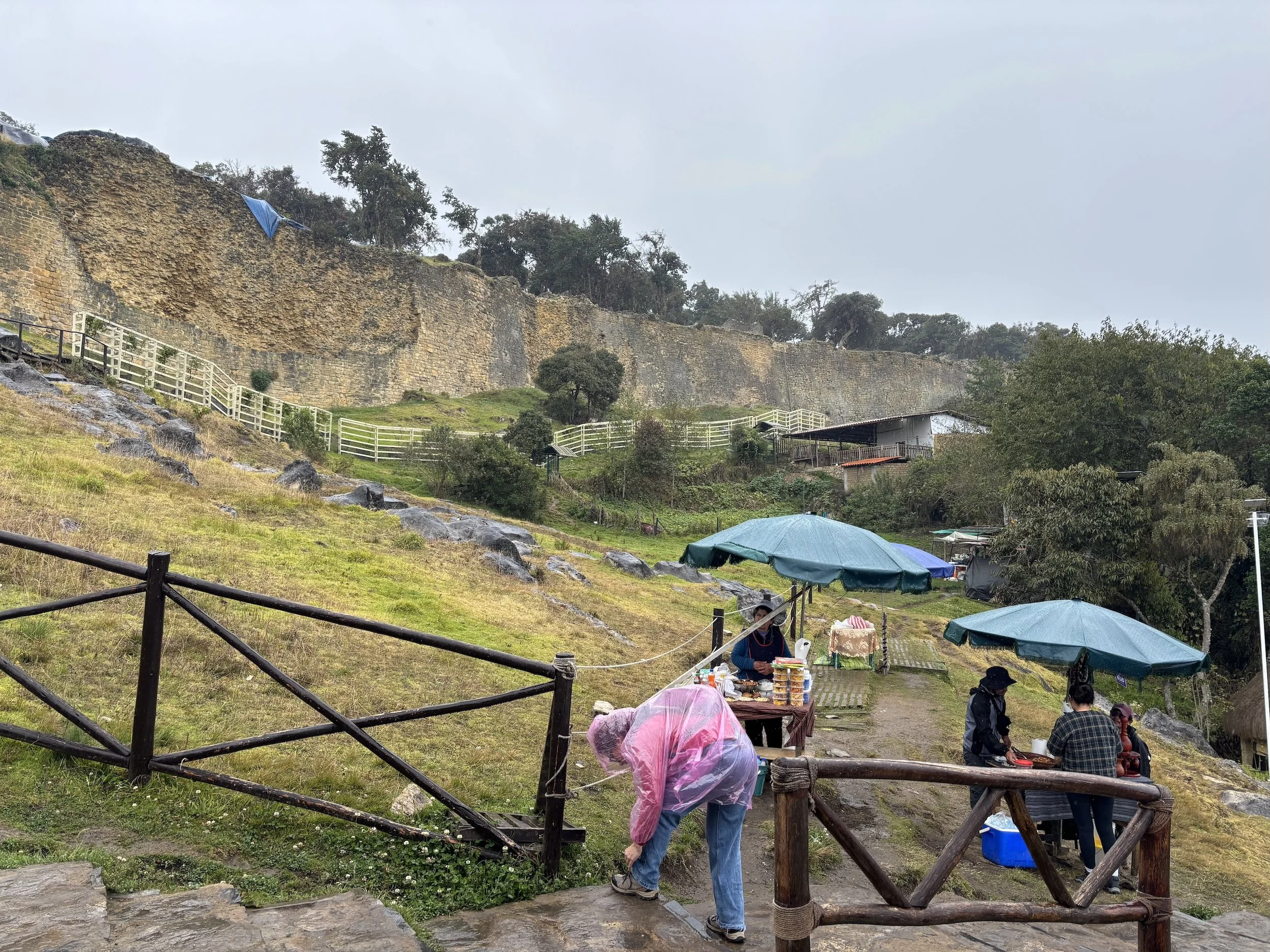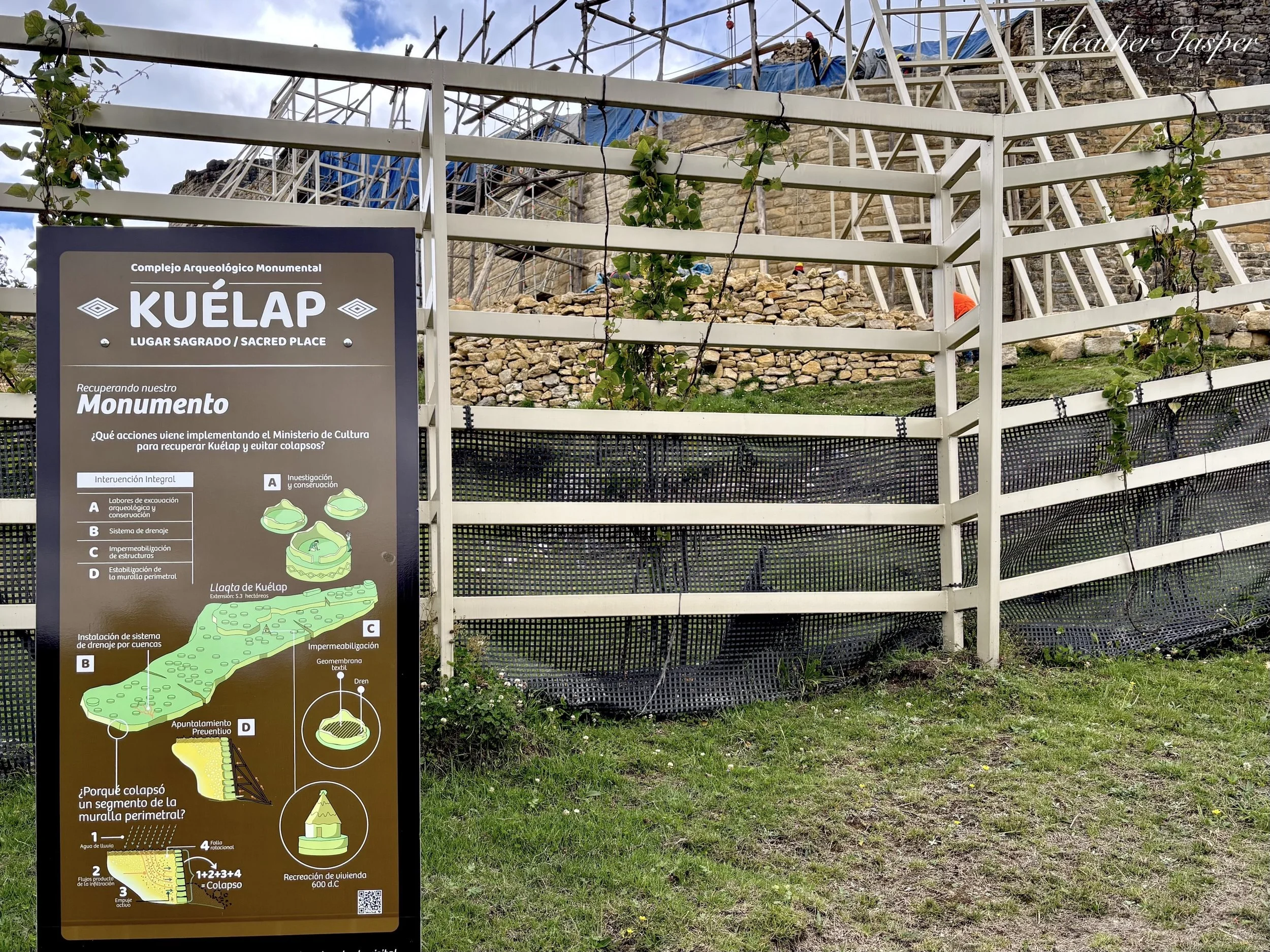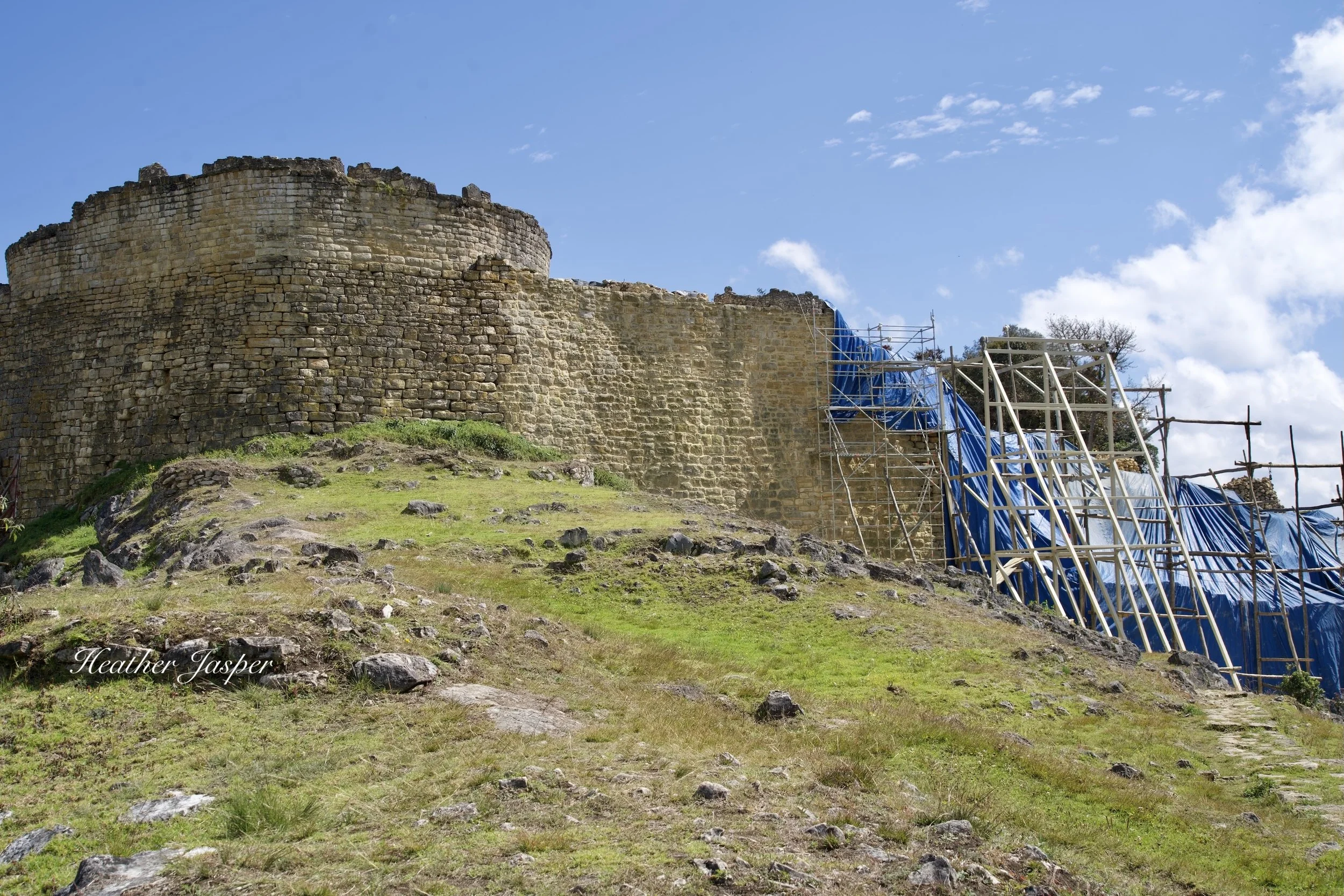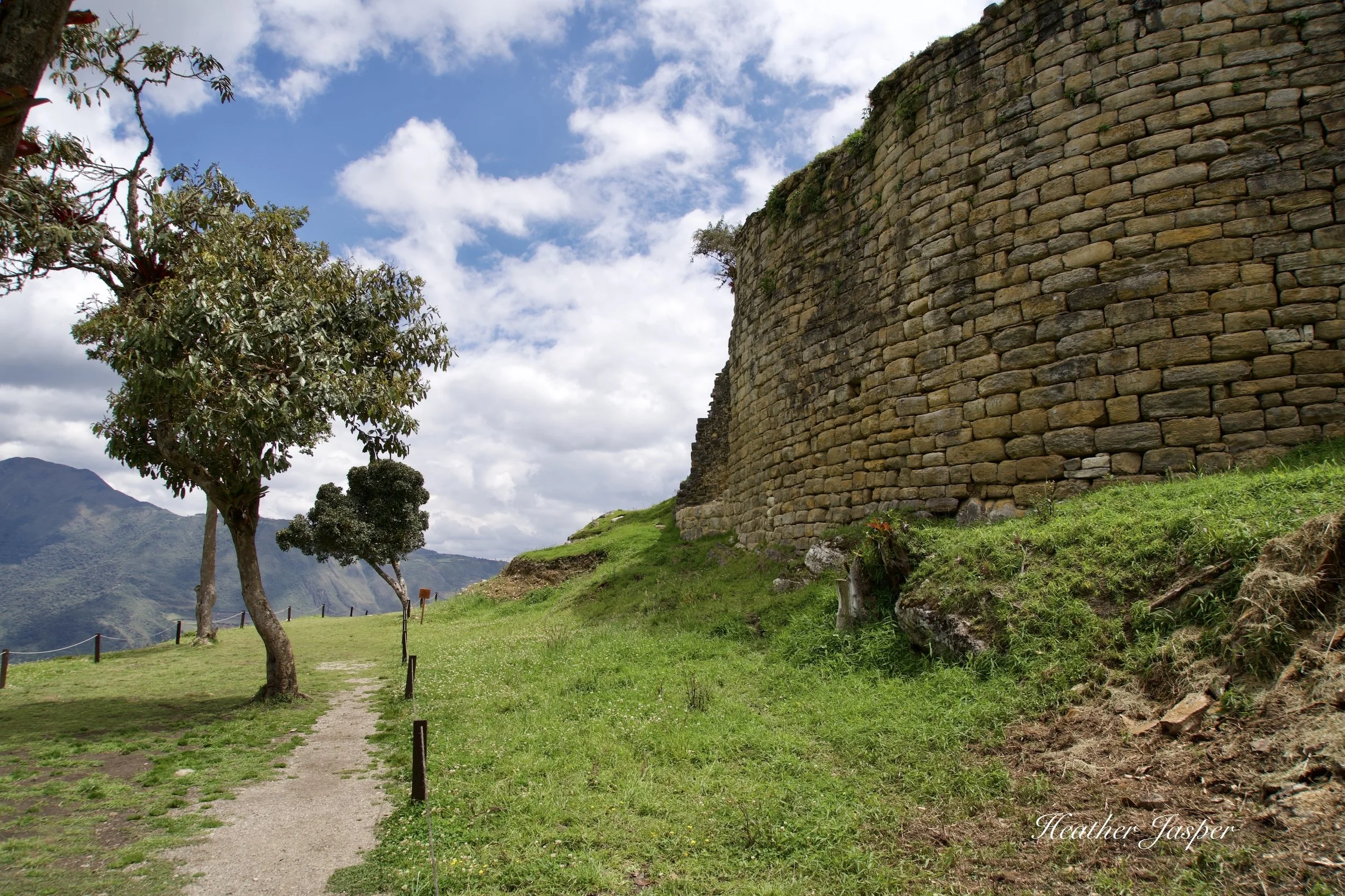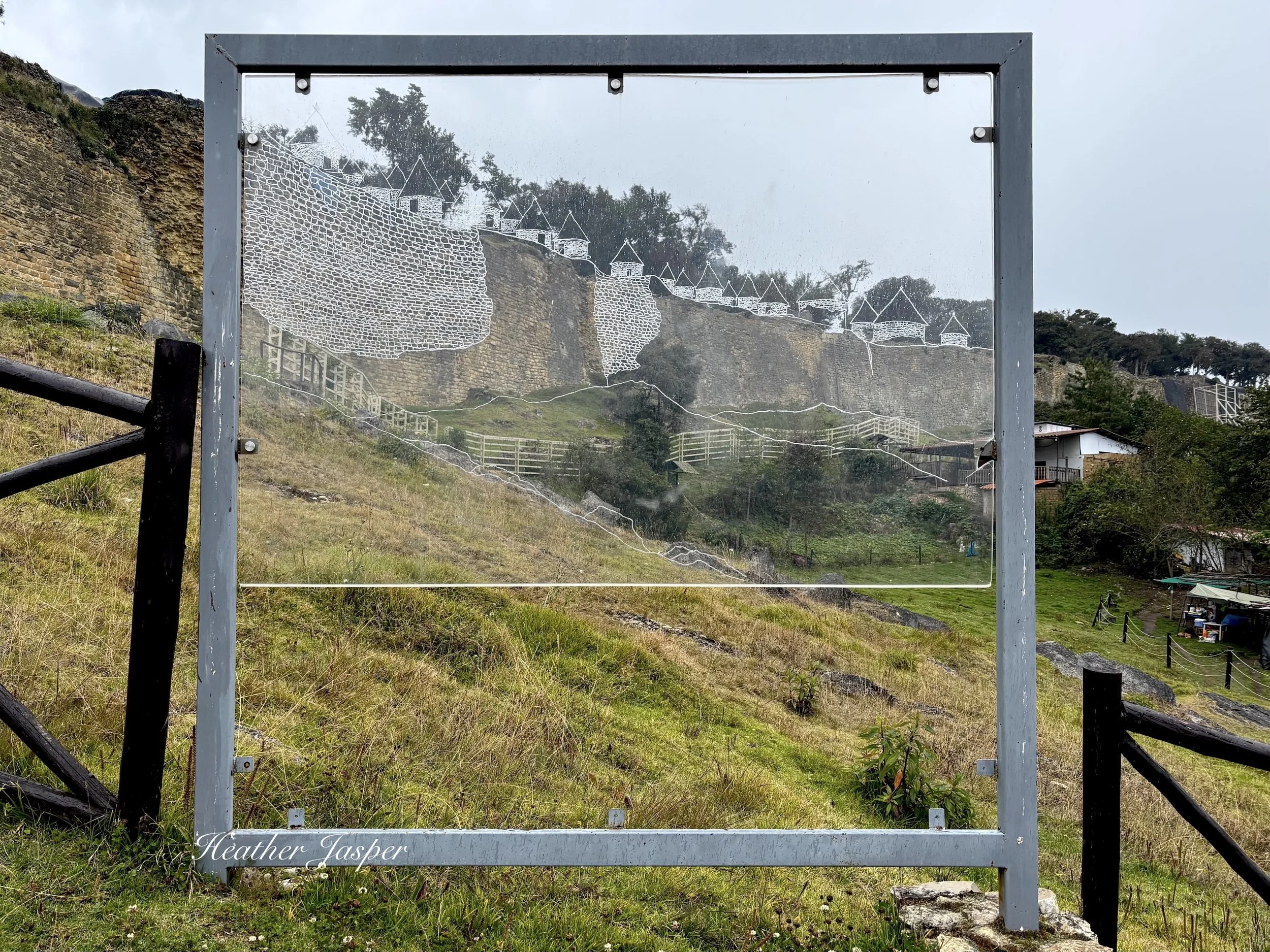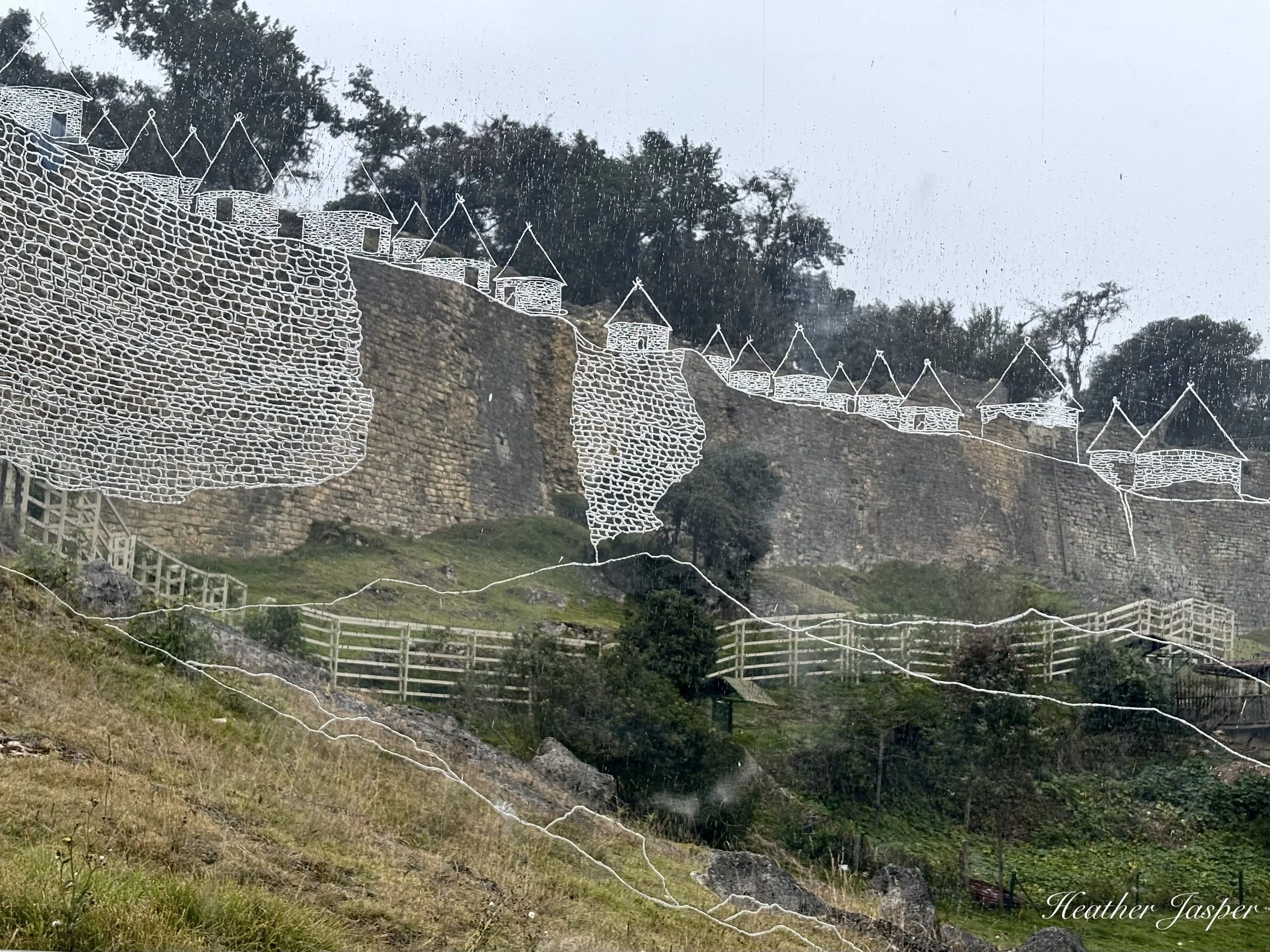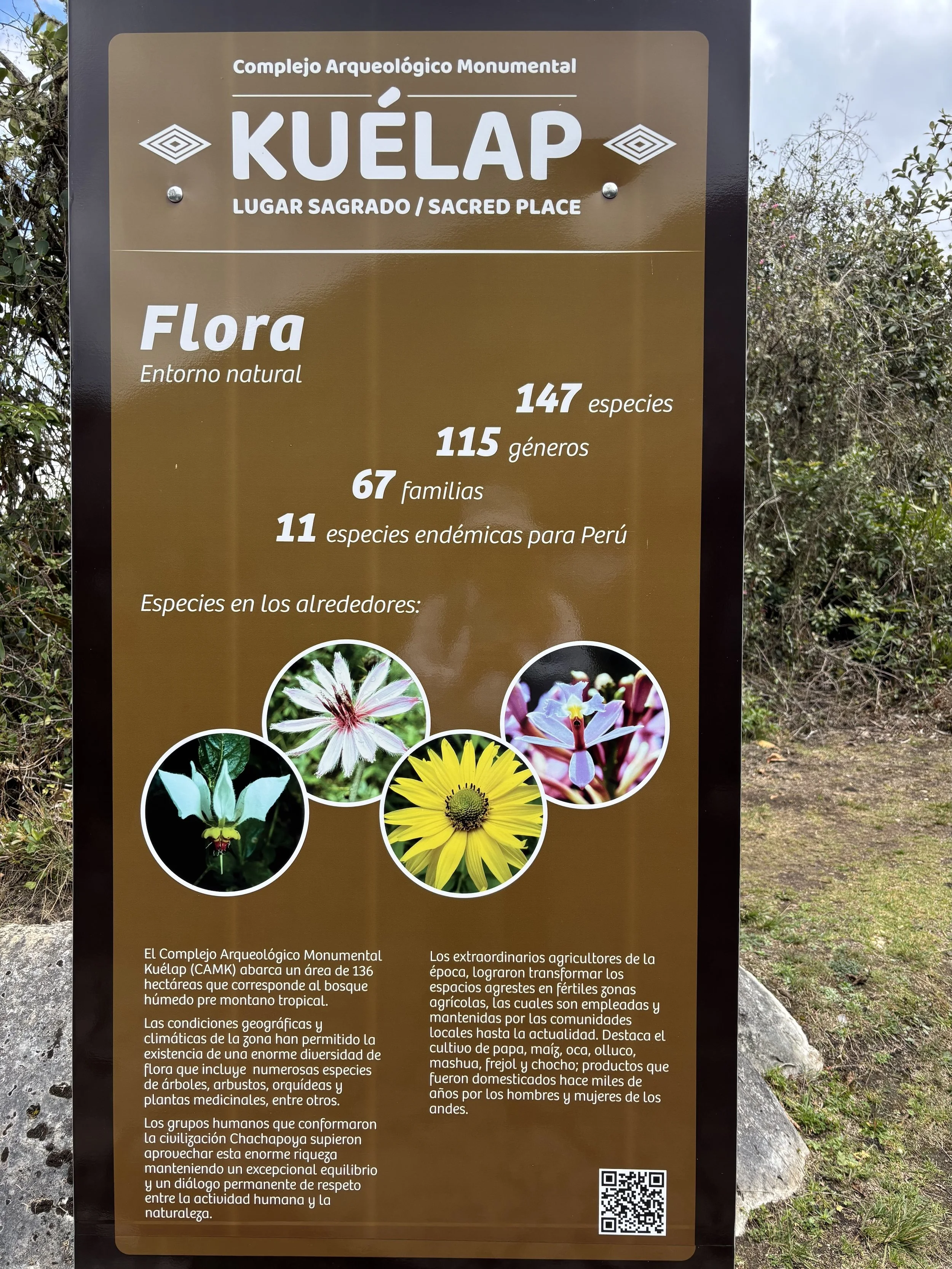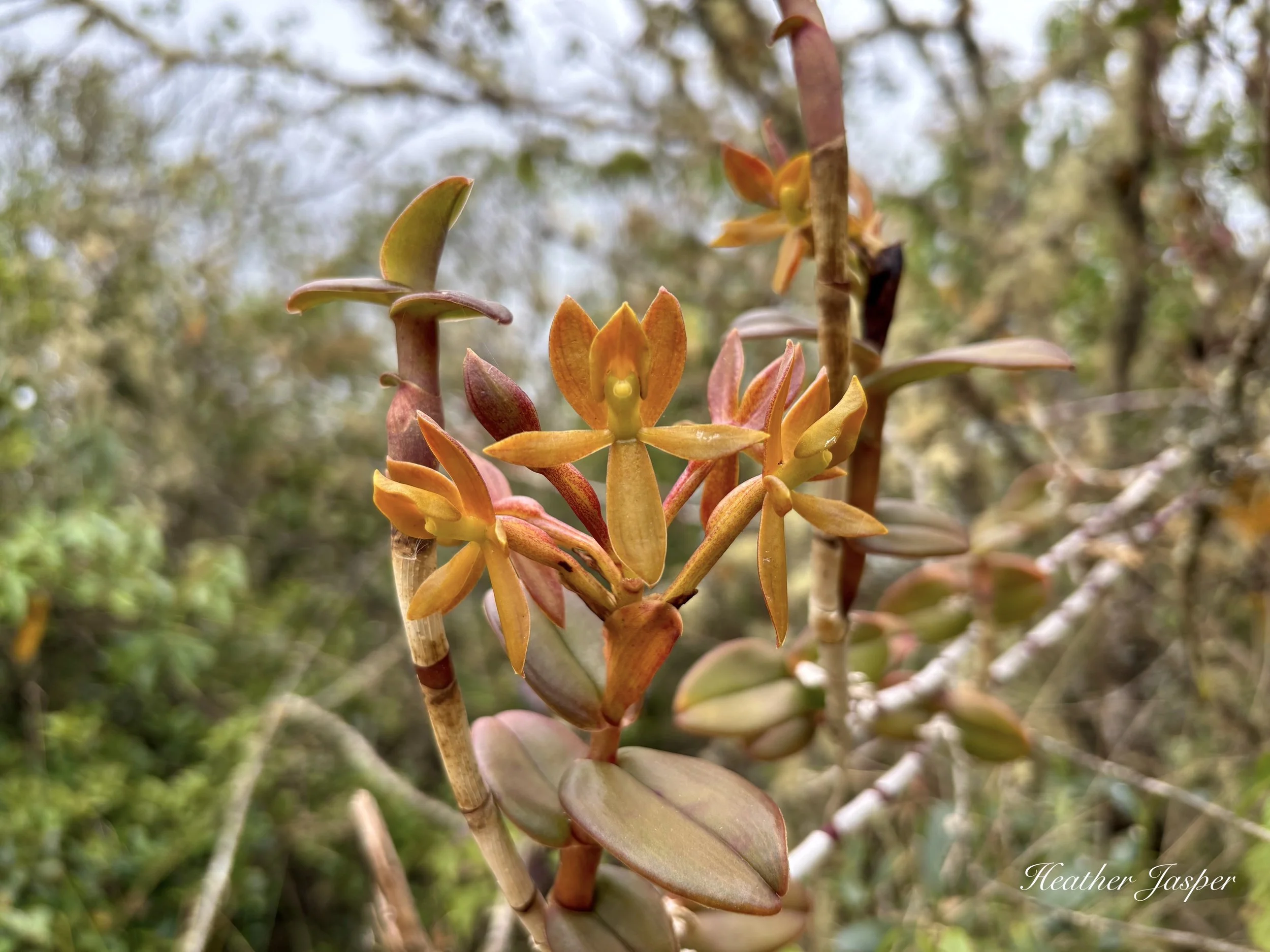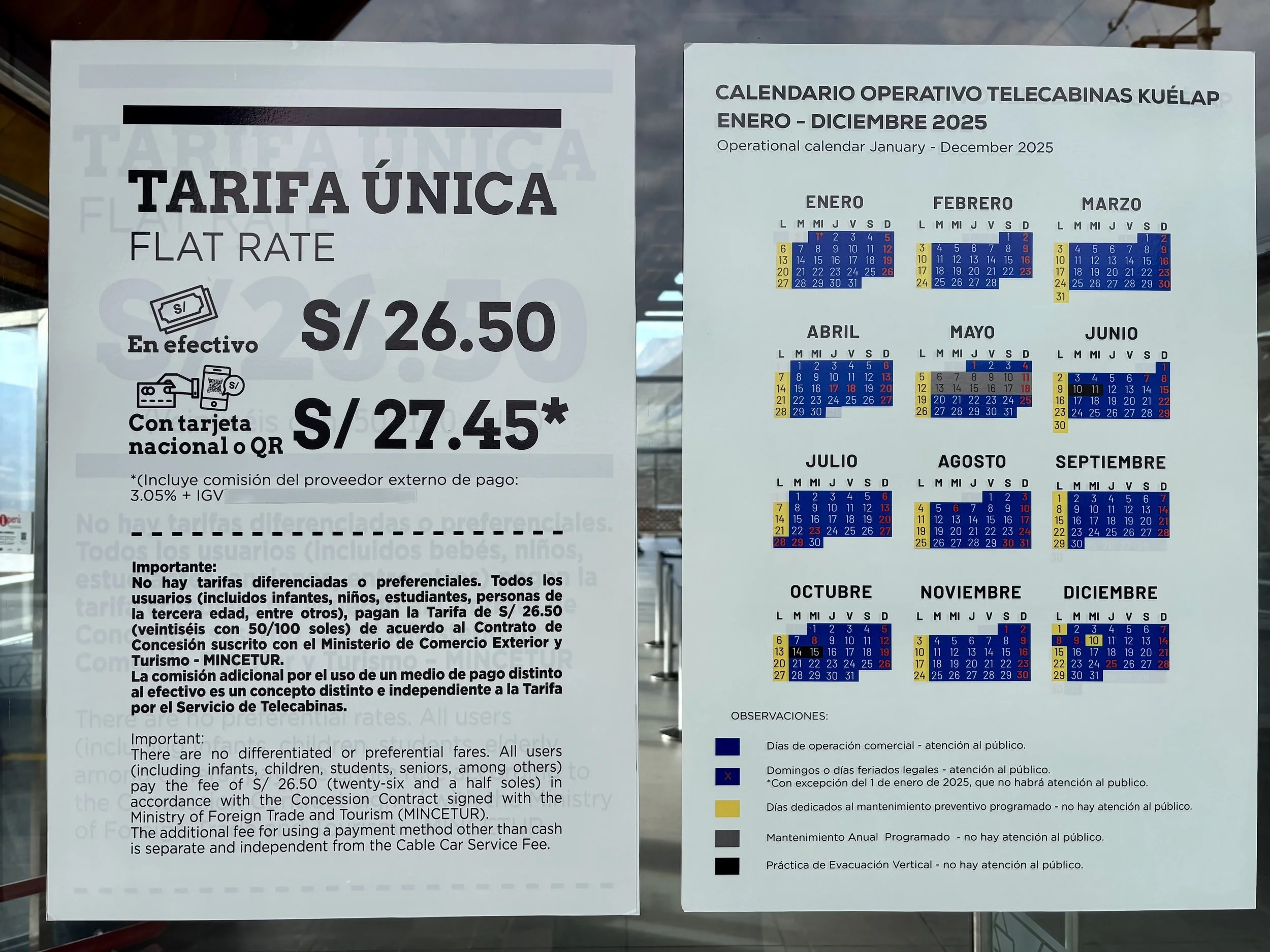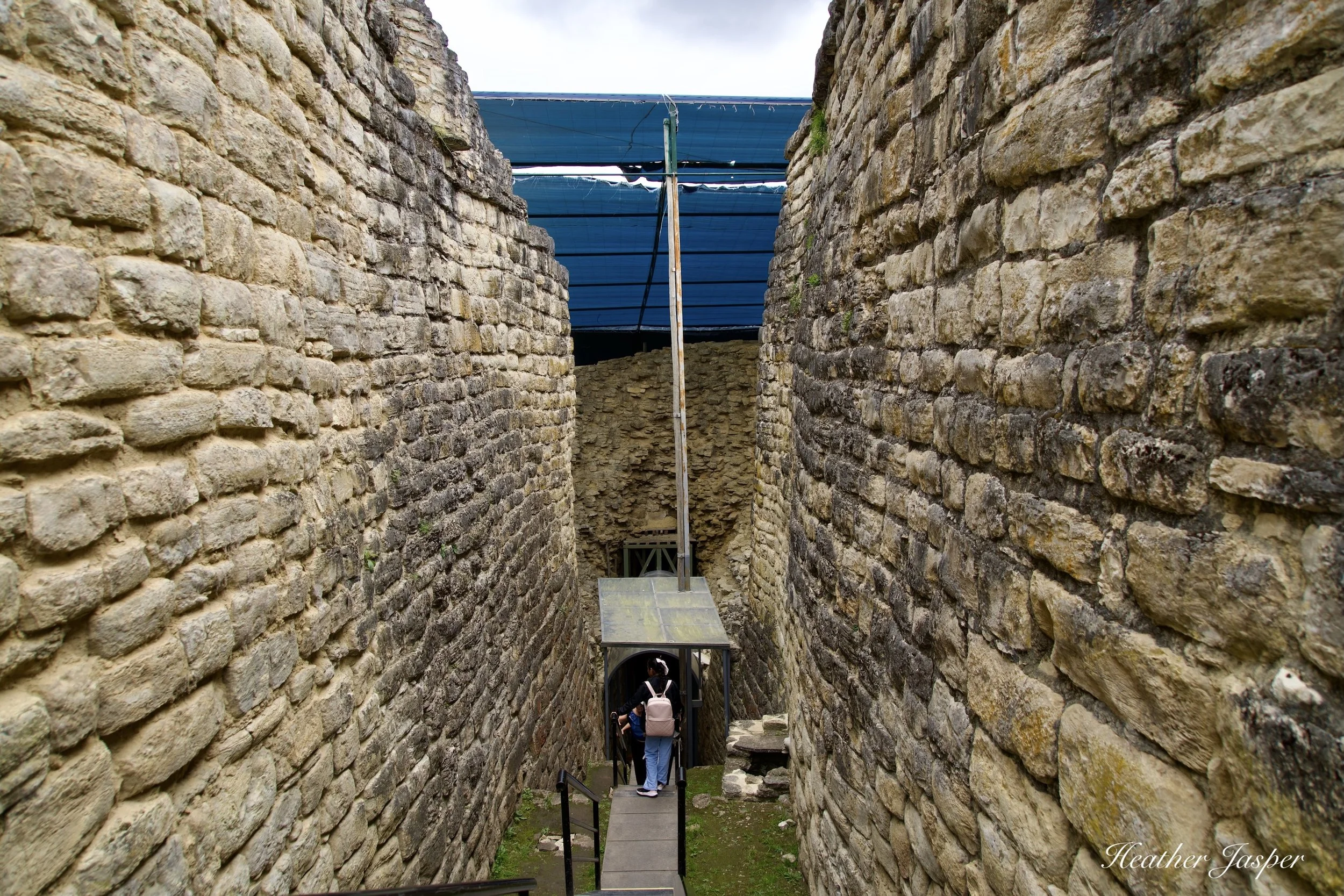How to visit Kuélap
Archeologists are still studying the Chachapoya’s round buildings in the cloud forest.
The Chachapoya ruled the cloud forests of northern Peru for over 900 years.
Sometimes called a civilization, and sometimes a culture, the Chachapoya people were both. They had a very distinct culture, with their own language, religious beliefs, art and architecture. The area that was the geographical center of their power is now called Chachapoyas, and it’s both a city and a province of the Peruvian Amazonas department. (Departments are like states and provinces are like counties).
I got to visit Kuélap twice!
The Chachapoya’s biggest city was called Kuélap. For the first visit, I had the honor of being accompanied by Jaime Remaycuna, Director of Visits, who oversees all aspects of the tourist experience at Kuélap, and archeologist Oliver Huamán Oros, Director of Kuélap. They showed me how excavations are going, since only about 20% of the city has been excavated so far. It was a fascinating visit, and I learned a lot from them.
Kuélap is at a pleasant 9,000 feet above sea level, high enough that it’s not hot and sticky like lowland jungle in this equatorial part of Peru. That’s not much higher than Machu Picchu’s 7,975 feet above sea level and a lot lower than Cusco’s 11,300 feet.
Kuélap’s main temple on my second, sunnier, visit. More about the temple below - keep reading!
My second visit was less planned. I woke up at the Utcubamba River Lodge and saw that it was sunny, which it hadn’t been for my visit with Jaime and Oliver. Over breakfast I checked the government website for tickets and found that only one other person had bought tickets for the earliest entrance, at 9am and more than a hundred tickets were still available. (See screenshots from my first visit below). That morning, I was able to visit and photograph most of the city before the clouds rolled in. Kuélap is in an area of cloud forest, so afternoons are reliably cloudy and rainy, even if the morning is clear.
Kuélap tickets are easy and plentiful.
For my first visit, I bought my ticket the night before, for a 10am entrance and on my second visit I bought my ticket that morning. For comparison, Machu Picchu tickets sell out weeks and sometimes months in advance. You are guaranteed long lines and lots of strangers in your photos at Machu Picchu. Kuélap is the opposite, which is one of the many reasons you should go now, before it gets more popular. Buy your tickets on the government website Tu Boleto.
This diamond pattern on this building shows it’s one of the most important at Kuélap.
Kuélap is a bargain.
My ticket for Kuélap was s/20 soles, since I’m a resident of Peru. Foreigners pay s/30 soles, which is only about $8.65 US dollars. As a publicly owned archeological site, the taxes that Peruvians pay partly fund the site’s maintenance and archeological study, hence the discount. For comparison, a Machu Picchu ticket for foreign tourists is around $44.
You get a great view of the nearby valleys from the Kuélap cable car. This was my first, cloudier, morning.
Kuélap has a fun cable car.
In March 2017, Kuélap’s cable cars, built by the French company Poma, welcomed their first visitors. The drive from the town of Tingo to Kuélap used to take about 2 hours, along a twisty, unpaved mountain road, which is frequently blocked by landslides in the rainy season from December to March. Today, you can take the cable car from Tingo right to Kuélap in about 20 minutes. Actually, there is a shuttle bus from Tingo about 15 minutes to where you get on the cable car, making it over half an hour each way. The shuttle and cable car cost s/26.50 ($7.65) round trip for everybody, regardless of age or nationality.
The trail from the cable car leads you to the south wall of Kuélap.
For comparison, visitors to Machu Picchu have to pay for a train, which takes two hours and costs between $70-$600 each way, depending on how fancy you want that train. The shuttle bus up to Machu Picchu is an additional $12 each way, though this will change soon as a new company is starting to run the route. For entrance tickets and transportation, that’s about $16 total for Kuélap and $208-$1,268 for Machu Picchu.
Atsa flies small planes to Chachapoyas and to other small airports throughout Peru.
How to get to Kuélap?
To get that $16 deal, you first have to fly from Lima to the city of Chachapoyas, which cost me $170 each way. Then you drive from Chachapoyas to Tingo, which cost me s/10 in a van, about $2.90. Flights to Cusco can be $100-300 each way, depending on the season and airline. Only one airline flies to Chachapoyas, Atsa, and there’s only one flight a day. So, you don’t have to waste your time comparing airline prices, but you also don’t have any choice.
Is it worth going to Chachapoyas?
I loved the whole Chachapoyas region and spent almost two weeks there, after my week in Tarapoto with Sachakuna and in Moyobamba with Ikam and Tingana. The cloud forest is beautiful and has impressive biodiversity and bird watching. There are about a dozen other amazing archeological sites that you can visit in the area, like Machu Picchu has the whole Sacred Valley full of archeological sites. Of everything I saw in my almost three weeks in the north, Kuélap was by far my favorite part, hence visiting twice. It is a truly fascinating and impressive city.
Visitors enter and exit through this narrow cleft in the city’s walls.
The Chachapoya started building Kuélap around 500CE.
Kuélap is one of the few words that survives from their language, though the meaning has been lost. Unlike other Indigenous languages in Perú (there are still 48), the Chachapoya language didn’t survive two successive defeats. After years of fighting, the Inca conquered them in 1470 and the Spanish in 1535.
Looking north from Kuélap, the Utcubamba River Valley stretches into the distance.
The Warriors of the Clouds
Unlike most ethnic groups in Peru, the Chachapoya put up a very fierce resistance to the Inca. Their impressive fighting and the fact that they ruled the cloud forest region, gave them the nickname the Warriors of the Clouds. Many other groups throughout the Andes agreed to Inca rule, which included paying tribute to the Inca in Cusco, after a combination of diplomacy and threats convinced them to give in without a fight.
The Chachapoya fought back.
The exact number of years they defended their lands and the city of Kuélap is debatable, depending on how you read the Spanish chronicles. Neither the Chachapoya nor the Inca recorded their history with years the same way Europeans did. However, estimates I’ve seen say that they fought from about 1470 to 1475.
There are a few square structures at Kuélap, which show the Inca’s presence in the late 1400s.
The Inca punished the Chachapoya.
One consequence of their resistance to the Inca was that after they lost, many were sent all over the Inca’s lands in a form of forced labor, also considered a form of paying tribute or taxes. This removed the strongest workers and fiercest fighters from Kuélap, making it much harder for the remaining Chachapoya to rebel against Inca rule. In the Cusco region, and other parts of Peru, major architectural and engineering achievements have Chachapoyan-style buildings nearby, showing that much of the labor was done by displaced Chachapoya workers.
The Chachapoya’s Attempted Revenge
When 20 Spanish under the command of Alonso de Alvarado arrived in 1535, the Chachapoya elite must have seen this chaos agent as a weapon to use against the Inca. Unfortunately, they completely underestimated the Spanish staying power and by the time they realized their mistake and started to fight the Spanish, it was too late.
Why was Kuélap abandoned?
While the Chachapoya people survived Inca domination and rule, they didn’t survive smallpox and other diseases brought by the Spanish. They still lived in Kuélap for about 60 years as subjects of the Inca, but abandoned the city after their population was decimated by the Spanish conquest and disease.
Anybody entering Kuélap had to pass through this narrow opening in the tall walls.
Why did the Chachapoya defend Kuélap?
Until I went to Kuélap, I didn’t understand why the Chachapoya would have resisted the Inca when so many other people gave in to Inca rule without a fight. Now I get it.
Kuélap is an engineering marvel that seems like it should have been easy to defend. It’s built on the top of a ridge with massive walls surrounding it that serve both as defense and to retain the flattened ridgetop where the city is built. They’re not the kind of walls you’d see at a European medieval city, where the wall is free standing and the inner buildings are below it. Kuélap’s wall is more like a terrace, where the ground that the city is built on is even with the top of the wall.
Running the Gauntlet
Imagine entering this city, with people peering down at you from the tops of the walls. Intimidating, right?
The West Entrance
The only entrance on the west wall is currently closed to the public.
The Northeast Entrance
This entrance is currently closed to the public while they reinforce an unstable wall.
Nearby Farms
From above the northeast entrance, you can see how close farms and houses are to Kuélap.
Only Three Entrances
There are only three slits in that massive wall. They look like they were natural fissures in the rock, which the Chachapoya developed into the city’s entrances and exits. Two are directly across from each other, around the middle of the city, and the third is farther north. The ridge is oriented north-south, with the most important temple, simply called the Templo Mayor or Major Temple, on the southern end of the city.
Like the Big Bang, I think scientists need to be more creative when naming truly amazing things, whether that’s natural phenomenon or ancient structures. I would call the temple the Bottle of Sacrifices or the Reverse Circular Pyramid or something like that. You’ll find out why in the next section.
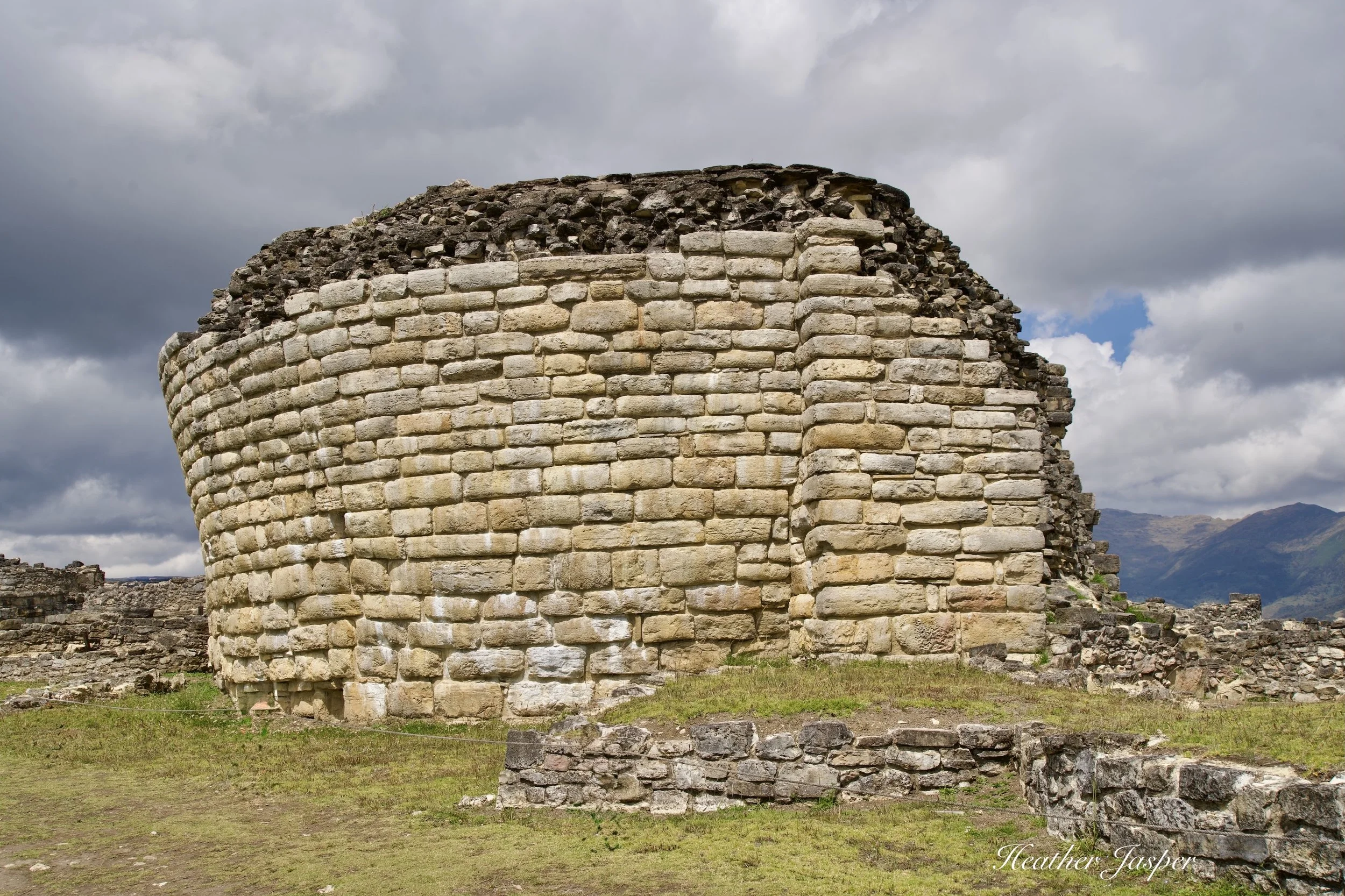
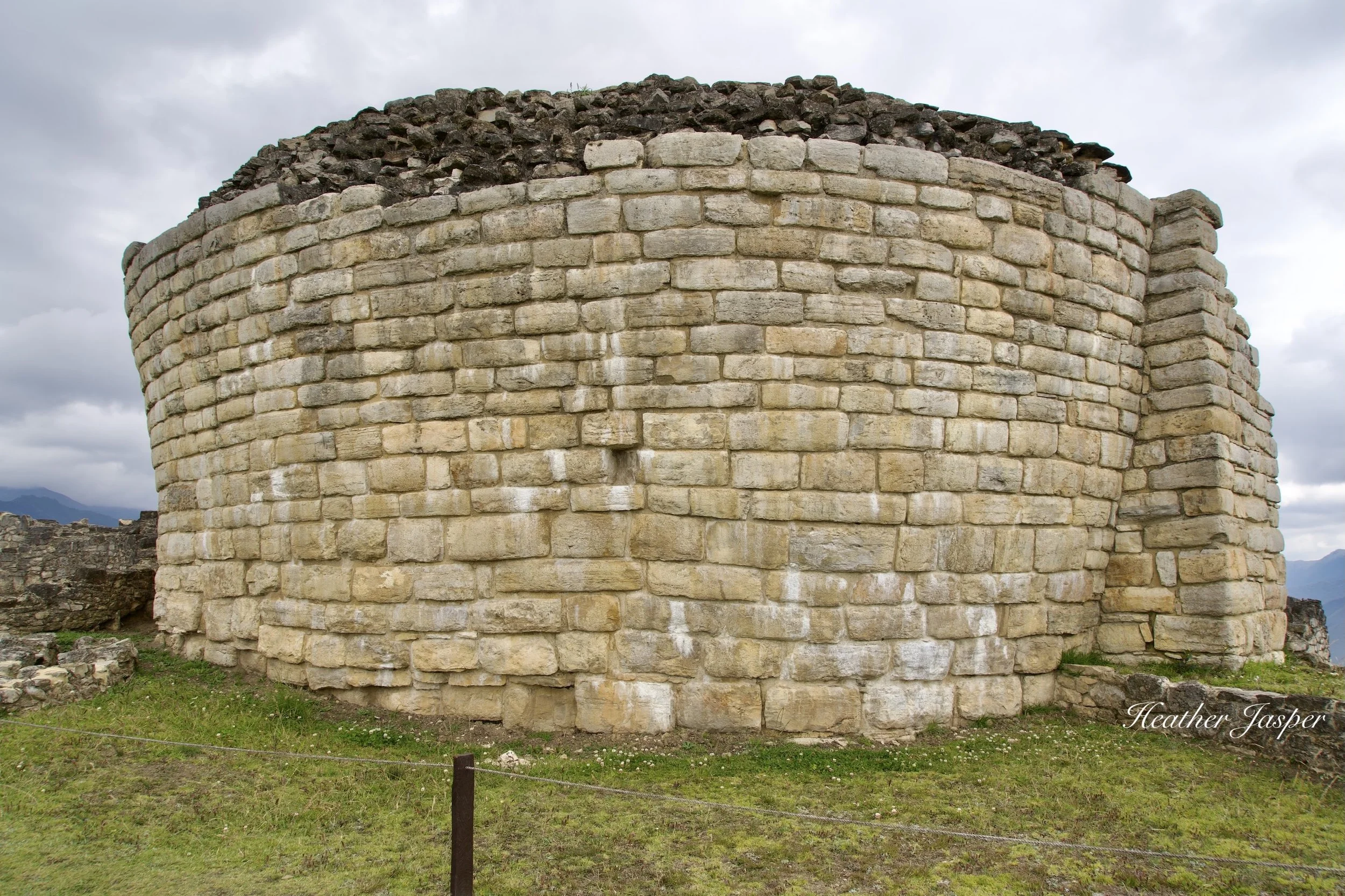
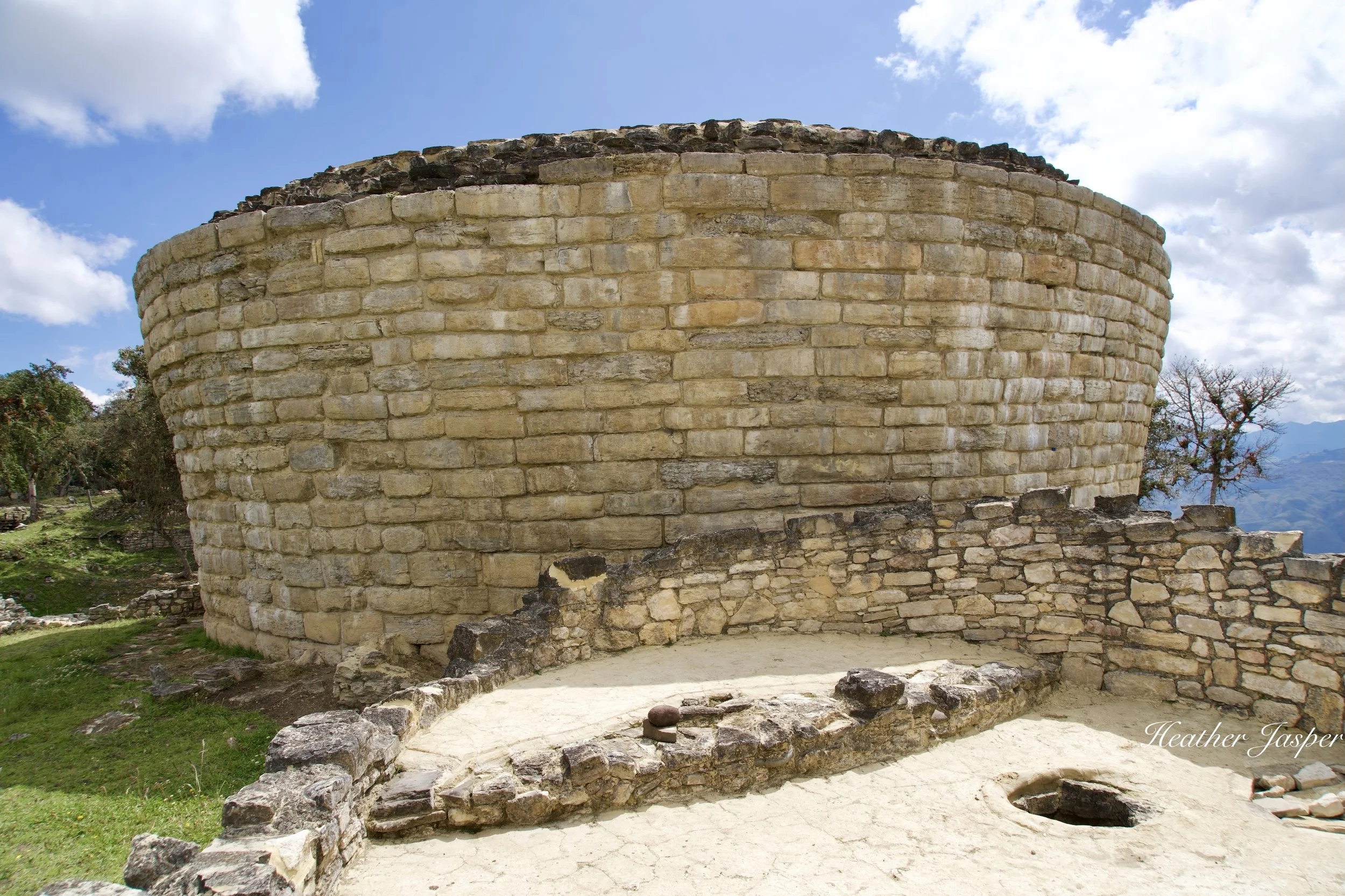
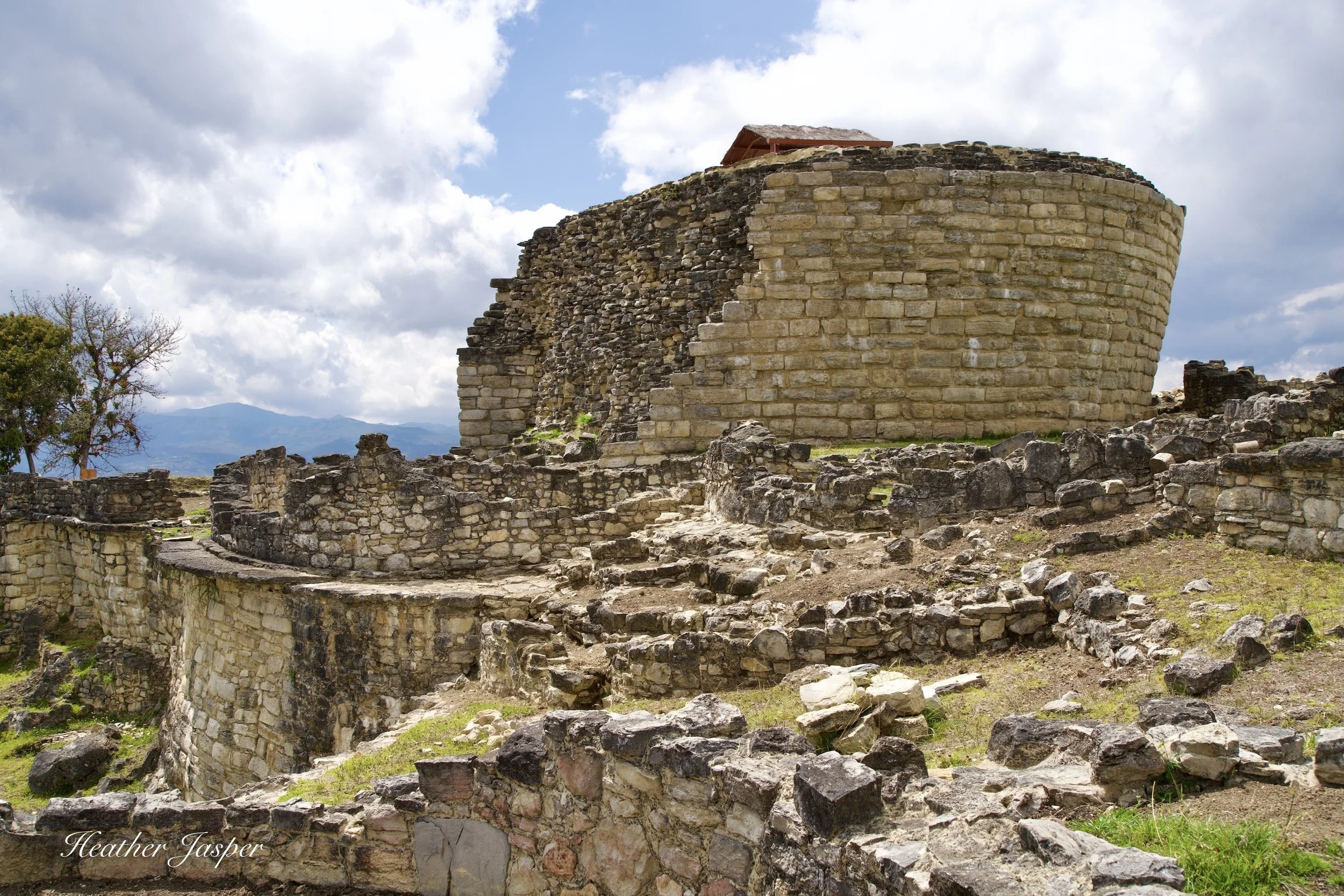
El Templo Mayor
The temple is an inverted, truncated cone, with the flat platform above wider than the base. Architecturally, this is not easy to achieve. Even today, few buildings have walls that lean out, and all of those rely on steel frames. The Chachapoya achieved this effect with only stone and a little mortar, though the north side of the temple collapsed before archeological studies began. According to Unesco rules, anything that collapsed before archeologists began their study cannot be reconstructed.
The Temple’s North Wall Collapse
You can see the temple is a solid construction of stone from where part of the northern wall collapsed.
(Unlike Inca temples and important structures, Chachapoyan buildings used mortar between the stones. Ironically, some of the Inca’s finest buildings with perfectly carved stones that fit together without mortar were probably built by Chachapoyan labor crews).
The Templo Mayor is solid, as you can see in the exhibit in Kuélap’s on-site museum. (Click on the photos to see them larger). In that respect, it’s like the city of Kuélap itself, with the city built level with top of the wall. However, inside the temple there is a bottle-shaped hole, wider at the bottom, an inverse of the temple itself which is wider at the top. It’s a truly unique structure and I don’t know of any other remotely similar anywhere else in Peru, or even anywhere in the world. (If you know one, please comment below).
The Bottle Cap
From a distance, you can see a small roof that protects the open top of the temple’s bottle-shaped inner chamber.
Inside that rounded hole in the middle archeologists have found all kinds of objects which were clearly offerings or sacrifices. Some are typical valuable objects, made with the same materials that I’ve seen used for offerings and sacred objects from Caral (5,000 years ago) to Sipán (1,800 years ago). These Chachapoya offerings, made between 1,300 and 500 years ago, are gold, silver, bronze, human and animal bones, and the spondylus shell. Spondylus is a mollusk that lives in deep water near the equator, which has been prized for its scarcity and color for over 5,000 years.
Houses in Kuélap still have their inner bench structures, mortar stones called batan for grinding corn and other food, and the drainage now hidden under the wooden grate.
Homes of Bones
Finding human bones in the Templo Mayor wasn’t surprising. As archeologists excavate Kuélap, they find that almost every building is full of bones. That’s because, as a city, most of the buildings were homes and the Chachapoya lived with their ancestors buried in their homes.
They didn’t bury recently deceased people inside, as that would obviously smell bad and invite disease into their homes. Rather, they buried people in temporary graves outside the walls of the city, then brought the bones home after the body had naturally decomposed. Since the floors of their homes were packed clay, they had to be refinished regularly anyway, so I suppose re-burying grandma’s bones inside was also an opportunity to refinish the floor.
What Kuélap really lacks is a classic postcard or selfie shot that tourists can go home with. If they allowed drones, everybody with a drone could take this artistic photo, on display in Kuélap’s museum.
The city was inhabited for over 900 years, so you can imagine that the oldest houses had generations of bones under the floor, while newer houses only had a few skeletons underfoot. Like any city, as younger generations of the Chachapoya grew up and started their own families, they built their own homes. Kuélap was no more a “finished” city than Paris is today. Homes in the center of Paris have been inhabited for hundreds of years, while apartment buildings on the outskirts were mostly built in the 1950s-1970s. They were still building until the Inca took away their workers and then the Spanish killed of almost everybody else.
These two houses have the distinctive patterns under their stone porches.
Chachapoya Architecture
The Chachapoya built circular buildings with a layer of flat stones sticking out of the walls at the level of the door, like a porch or veranda, which was sometime sat ground level and sometimes several feet up in the air. I saw homes built on a bit of a slope, so their doorstep and balcony were five to six feet up, while the back wall of the house was basically at ground level.
Important buildings also had a layer of zig zag stones or sideways diamond shapes, like flattened rhombuses. Archeologists are still working out the exact meeting and why some buildings had this but not others, while common sense says they’re clearly eyes, watching the population around them.
I also saw these rhombus eyes at the archeological site of Yálape, which I’ll write about in my next blog.
You can see the stone porches that went around every house at floor level, not ground level.
Kuélap Today
The Kuélap Archeological Complex is 136 hectares (336 acres) and, according to the regional Director of the Ministry of Culture, Rocio Sánchez, has five more archeological sites besides the city I visited. Like Machu Picchu, the main city of Kuélap is called the llaqta, a Quechua word that means city. The outlying villages each have their own name.
Threats to Kuélap
When you visit Kuélap, please do not buy anything from the people selling food and souvenirs near the llaqta. Before Kuélap was a protected archeological site, and while it was basically unguarded during the pandemic, people moved in and built homes very close to the east walls. In both photos above you can see that the fence between Kuélap and the houses doesn’t actually protect the site.
Archeologists who understand how delicate Kuélap is have tried, so far in vain, to convince people to move farther from the site. However, as long as they can make a living off the tourists that come to Kuélap, they are unlikely to go.
It has been a complicated process but the restoration will be completed by the end of 2025.
The South Wall Collapse
In 2022, a large section of Kuélap’s southern wall collapsed. The whole site had to be closed for most of 2023, and it only reopened in 2024. It was a huge blow to the local tourism industry, which had a major effect on the local economy. Like Cusco, tourism is an important part of Chachapoyas’ economy.
The wall collapsed because the ground above it was saturated and too heavy for the wall to contain. That section of the city is densely packed with houses, which obviously had roofs when people lived there. Rain ran off the roofs and down gutters out of the city. The past 500 years, without any roofs, the ground has absorbed all that rainfall. Remember, this is an area of cloud forest, and it rains a lot in cloud forests.
A 3-year project
Restoration of the south wall didn’t begin until 2023, so if they finish by the end of 2025 that will have been three years.
However, there were some benefits to the wall’s collapse. During the reconstruction, archeologists found evidence that the wall had collapsed before and that the Chachapoya had to rebuild it at least once before. They’re getting a lot of information out of the ground during the restoration process.
When Kuélap reopened in 2024, this northwestern part of the city was open to the public for the first time. Now, there is more area of Kuélap open to the public than before the south wall collapsed.
Above is an artist rendition of what the east wall of Kuélap would have looked like 600 years ago.
New/Old Drainage Systems
Rather than building up walls higher than they were found, or putting roofs on them, archeologists have put a central drainage point in most houses, with a plastic membrane covered by an inch of soil that funnels all the rain into that drainage point. They have found the ancient drainage systems built well over a thousand years ago and started to use them again. (The walls you see in Kuélap were not built or reconstructed. Standing walls have been excavated and reinforced, but not built up higher than found).
The biodiversity in Peru’s northern cloud forests is some of the best in the world.
Hundreds of Orchids
Hundreds of species of orchids live in the cloud forests around Kuélap and over 3,500 in this region of northern Peru.
There is a surcharge for using a credit card. Always check the current year’s scheduled maintenance.
How to Visit Kuélap?
Be aware that the cable car is closed every Monday for maintenance. There is also a 2-week period in May that it’s closed for maintenance and twice a year they close for two days to practice vertical evacuations. While that means the cable car is very safe, it’s a pain for people who don’t plan their trip around the scheduled maintenance closures.
I’ve already outlined the cost and transportation to get to Kuélap, but you also need to know that few guides are available at the site and only three speak English. If you are visiting Peru with a package tour, your guide will go with you to Chachapoyas and Kuélap. They will translate for a local guide who works exclusively at Kuélap and is an expert in the site. Few guides who lead groups to multiple places around Peru are experts in every place that you’ll visit, so they will work with local experts at each place, like at Kuélap.
The current entrance and exit goes through an ancient tunnel in the city’s east wall.
It's about a half hour walk from where you get off the cable car to the site, and it’s about a 2-hour walk around the city to see the whole thing. I did about 10,000 steps at Kuélap, including the hike from the cable car. If that seems like too much, pay for a horse to the llaqta’s entrance, which cuts out almost all the uphill and downhill in the hike. The llaqta itself is relatively flat, so the only up and down you’d have to do is in and out of the city up the narrow entrance.


